|
SNAP Library 2.2, Developer Reference
2014-03-11 19:15:55
SNAP, a general purpose, high performance system for analysis and manipulation of large networks
|
|
SNAP Library 2.2, Developer Reference
2014-03-11 19:15:55
SNAP, a general purpose, high performance system for analysis and manipulation of large networks
|
#include <agmdirected.h>
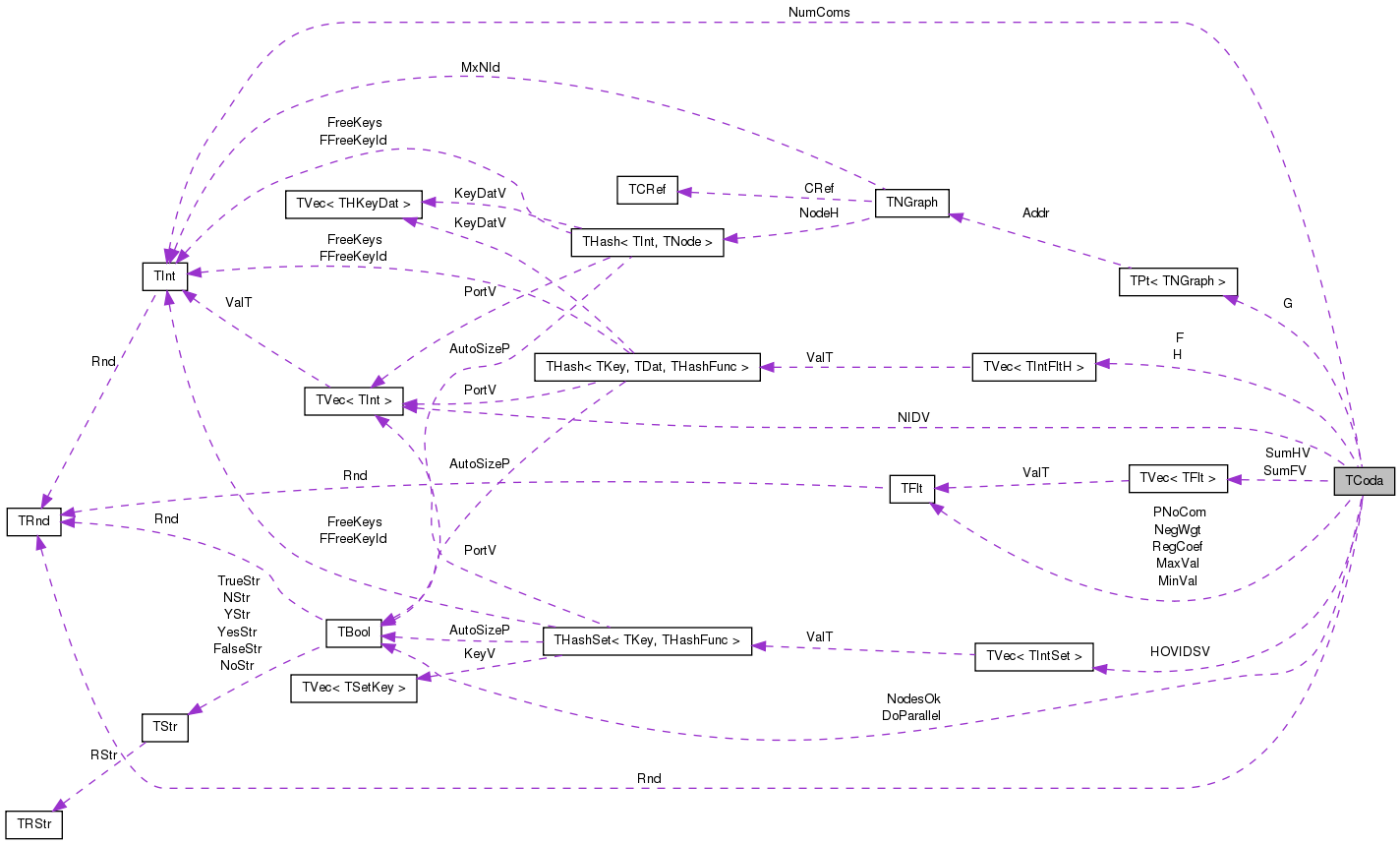
Public Member Functions | |
| TCoda (const PNGraph &GraphPt, const int &InitComs, const int RndSeed=0) | |
| TCoda () | |
| void | SetGraph (const PNGraph &GraphPt) |
| PNGraph | GetGraph () |
| PNGraph | GetGraphRawNID () |
| void | SetRegCoef (const double _RegCoef) |
| double | GetRegCoef () |
| void | RandomInit (const int InitComs) |
| int | GetNumComs () |
| void | NeighborComInit (const int InitComs) |
| void | NeighborComInit (TFltIntPrV &NIdPhiV, const int InitComs) |
| void | SetCmtyVV (const TVec< TIntV > &CmtyVVOut, const TVec< TIntV > &CmtyVVIn) |
| double | Likelihood (const bool DoParallel=false) |
| double | LikelihoodForNode (const bool IsRow, const int UID) |
| double | LikelihoodForNode (const bool IsRow, const int UID, const TIntFltH &FU) |
| void | GetNonEdgePairScores (TFltIntIntTrV &ScoreV) |
| void | GetNIDValH (TIntFltH &NIdValInOutH, TIntFltH &NIdValOutH, TIntFltH &NIdValInH, const int CID, const double Thres) |
| void | DumpMemberships (const TStr &OutFNm, const TStrHash< TInt > &NodeNameH) |
| void | DumpMemberships (const TStr &OutFNm, const TStrHash< TInt > &NodeNameH, const double Thres) |
| void | GetCmtyS (TIntSet &CmtySOut, TIntSet &CmtySIn, const int CID, const double Thres) |
| void | DumpMemberships (const TStr &OutFNm, const double Thres) |
| void | DumpMemberships (const TStr &OutFNm) |
| void | GetCommunity (TIntV &CmtyVIn, TIntV &CmtyVOut, const int CID) |
| void | GetCommunity (TIntV &CmtyVIn, TIntV &CmtyVOut, const int CID, const double Thres) |
| extract community affiliation for given community ID | |
| void | GetTopCIDs (TIntV &CIdV, const int TopK, const int IsAverage=1, const int MinSz=1) |
| void | GradientForNode (const bool IsRow, const int UID, TIntFltH &GradU, const TIntSet &CIDSet) |
| void | SetHoldOut (const double HOFrac) |
| void | GetCmtyVV (TVec< TIntV > &CmtyVVOut, TVec< TIntV > &CmtyVVIn, const int MinSz=3) |
| void | GetCmtyVV (TVec< TIntV > &CmtyVVOut, TVec< TIntV > &CmtyVVIn, const double ThresOut, const double ThresIn, const int MinSz=3) |
| void | GetCmtyVV (const bool IsOut, TVec< TIntV > &CmtyVV) |
| void | GetCmtyVV (const bool IsOut, TVec< TIntV > &CmtyVV, const double Thres, const int MinSz=3) |
| extract community affiliation for outgoing edges from F_uc | |
| void | GetCmtyVVUnSorted (const bool IsOut, TVec< TIntV > &CmtyVV, const double Thres, const int MinSz=3) |
| void | GetCmtyVVUnSorted (TVec< TIntV > &CmtyVVOut, TVec< TIntV > &CmtyVVIn) |
| int | FindComsByCV (TIntV &ComsV, const double HOFrac=0.2, const int NumThreads=20, const TStr PlotLFNm=TStr(), const int EdgesForCV=100, const double StepAlpha=0.3, const double StepBeta=0.1) |
| int | FindComsByCV (const int NumThreads, const int MaxComs, const int MinComs, const int DivComs, const TStr OutFNm, const int EdgesForCV=100, const double StepAlpha=0.3, const double StepBeta=0.3) |
| estimate number of communities using cross validation | |
| double | LikelihoodHoldOut (const bool DoParallel=false) |
| double | GetStepSizeByLineSearch (const bool IsRow, const int UID, const TIntFltH &DeltaV, const TIntFltH &GradV, const double &Alpha, const double &Beta, const int MaxIter=10) |
| int | MLEGradAscent (const double &Thres, const int &MaxIter, const TStr PlotNm, const double StepAlpha=0.3, const double StepBeta=0.1) |
| int | MLEGradAscentParallel (const double &Thres, const int &MaxIter, const int ChunkNum, const int ChunkSize, const TStr PlotNm, const double StepAlpha=0.3, const double StepBeta=0.1) |
| int | MLEGradAscentParallel (const double &Thres, const int &MaxIter, const int ChunkNum, const TStr PlotNm=TStr(), const double StepAlpha=0.3, const double StepBeta=0.1) |
| void | Save (TSOut &SOut) |
| void | Load (TSIn &SIn, const int &RndSeed=0) |
| TFlt & | GetSumVal (const bool IsOut, const int CID) |
| double | GetCom (const bool IsOut, const int &NID, const int &CID) |
| double | GetComOut (const int &NID, const int &CID) |
| double | GetComIn (const int &NID, const int &CID) |
| void | AddCom (const bool IsOut, const int &NID, const int &CID, const double &Val) |
| void | AddComOut (const int &NID, const int &CID, const double &Val) |
| void | AddComIn (const int &NID, const int &CID, const double &Val) |
| void | DelCom (const bool IsOut, const int &NID, const int &CID) |
| void | DelComOut (const int &NID, const int &CID) |
| void | DelComIn (const int &NID, const int &CID) |
| double | DotProduct (const TIntFltH &UV, const TIntFltH &VV) |
| double | DotProductUtoV (const int &UID, const int &VID) |
| double | Prediction (const TIntFltH &FU, const TIntFltH &HV) |
| double | Prediction (const int &UID, const int &VID) |
| double | Sum (const TIntFltH &UV) |
| double | Norm2 (const TIntFltH &UV) |
Public Attributes | |
| TFlt | MinVal |
| TFlt | MaxVal |
| TFlt | NegWgt |
| TFlt | PNoCom |
| TBool | DoParallel |
Private Attributes | |
| PNGraph | G |
| TVec< TIntFltH > | F |
| TVec< TIntFltH > | H |
| TRnd | Rnd |
| TIntV | NIDV |
| TFlt | RegCoef |
| TFltV | SumFV |
| TFltV | SumHV |
| TBool | NodesOk |
| TInt | NumComs |
| TVec< TIntSet > | HOVIDSV |
Definition at line 7 of file agmdirected.h.
| TCoda::TCoda | ( | const PNGraph & | GraphPt, |
| const int & | InitComs, | ||
| const int | RndSeed = 0 |
||
| ) | [inline] |
Definition at line 27 of file agmdirected.h.
References RandomInit(), and SetGraph().
: Rnd(RndSeed), RegCoef(0), NodesOk(true), MinVal(0.0), MaxVal(1000.0), NegWgt(1.0) { SetGraph(GraphPt); RandomInit(InitComs); }
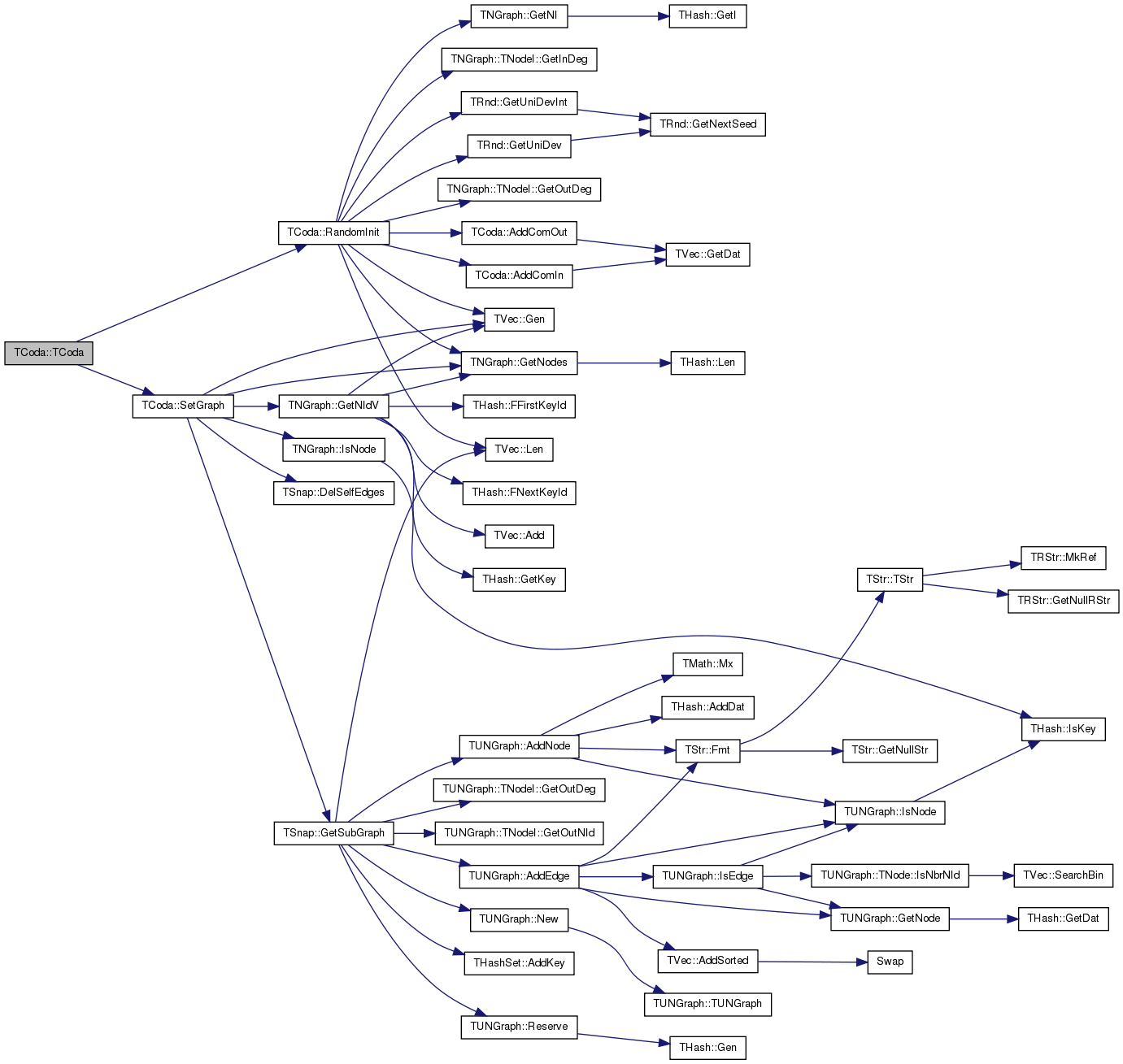
| TCoda::TCoda | ( | ) | [inline] |
Definition at line 29 of file agmdirected.h.
References G, and TNGraph::New().
{ G = TNGraph::New(); }

| void TCoda::AddCom | ( | const bool | IsOut, |
| const int & | NID, | ||
| const int & | CID, | ||
| const double & | Val | ||
| ) | [inline] |
Definition at line 114 of file agmdirected.h.
References AddComIn(), and AddComOut().
Referenced by MLEGradAscent().


| void TCoda::AddComIn | ( | const int & | NID, |
| const int & | CID, | ||
| const double & | Val | ||
| ) | [inline] |
Definition at line 128 of file agmdirected.h.
References TVec< TVal, TSizeTy >::GetDat(), H, and SumHV.
Referenced by AddCom(), NeighborComInit(), RandomInit(), and SetCmtyVV().
{
if (H[NID].IsKey(CID)) {
SumHV[CID] -= H[NID].GetDat(CID);
}
H[NID].AddDat(CID) = Val;
SumHV[CID] += Val;
}


| void TCoda::AddComOut | ( | const int & | NID, |
| const int & | CID, | ||
| const double & | Val | ||
| ) | [inline] |
Definition at line 121 of file agmdirected.h.
References F, TVec< TVal, TSizeTy >::GetDat(), and SumFV.
Referenced by AddCom(), NeighborComInit(), RandomInit(), and SetCmtyVV().
{
if (F[NID].IsKey(CID)) {
SumFV[CID] -= F[NID].GetDat(CID);
}
F[NID].AddDat(CID) = Val;
SumFV[CID] += Val;
}


| void TCoda::DelCom | ( | const bool | IsOut, |
| const int & | NID, | ||
| const int & | CID | ||
| ) | [inline] |
Definition at line 135 of file agmdirected.h.
References DelComIn(), and DelComOut().
Referenced by MLEGradAscent().


| void TCoda::DelComIn | ( | const int & | NID, |
| const int & | CID | ||
| ) | [inline] |
| void TCoda::DelComOut | ( | const int & | NID, |
| const int & | CID | ||
| ) | [inline] |
| double TCoda::DotProduct | ( | const TIntFltH & | UV, |
| const TIntFltH & | VV | ||
| ) | [inline] |
Definition at line 154 of file agmdirected.h.
References THash< TKey, TDat, THashFunc >::BegI(), THash< TKey, TDat, THashFunc >::EndI(), THash< TKey, TDat, THashFunc >::GetDat(), THash< TKey, TDat, THashFunc >::IsKey(), and THash< TKey, TDat, THashFunc >::Len().
Referenced by DotProductUtoV(), GetStepSizeByLineSearch(), LikelihoodForNode(), and Prediction().
{
double DP = 0;
if (UV.Len() > VV.Len()) {
for (TIntFltH::TIter HI = UV.BegI(); HI < UV.EndI(); HI++) {
if (VV.IsKey(HI.GetKey())) {
DP += VV.GetDat(HI.GetKey()) * HI.GetDat();
}
}
} else {
for (TIntFltH::TIter HI = VV.BegI(); HI < VV.EndI(); HI++) {
if (UV.IsKey(HI.GetKey())) {
DP += UV.GetDat(HI.GetKey()) * HI.GetDat();
}
}
}
return DP;
}
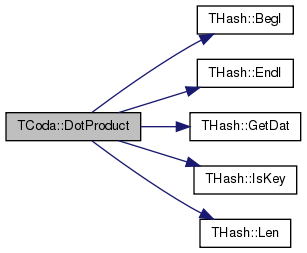

| double TCoda::DotProductUtoV | ( | const int & | UID, |
| const int & | VID | ||
| ) | [inline] |
Definition at line 171 of file agmdirected.h.
References DotProduct(), F, and H.
{
return DotProduct(F[UID], H[VID]);
}
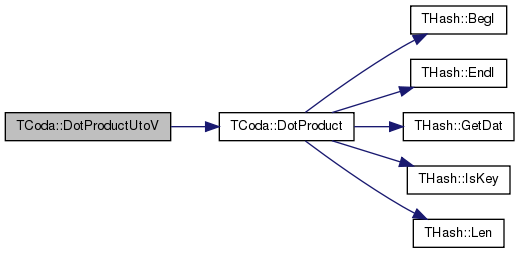
| void TCoda::DumpMemberships | ( | const TStr & | OutFNm, |
| const TStrHash< TInt > & | NodeNameH | ||
| ) | [inline] |
Definition at line 45 of file agmdirected.h.
References DumpMemberships(), and PNoCom.
Referenced by DumpMemberships().
{ DumpMemberships(OutFNm, NodeNameH, sqrt(PNoCom)); }


| void TCoda::DumpMemberships | ( | const TStr & | OutFNm, |
| const TStrHash< TInt > & | NodeNameH, | ||
| const double | Thres | ||
| ) |
Definition at line 617 of file agmdirected.cpp.
References TStr::CStr(), G, THash< TKey, TDat, THashFunc >::GetKey(), TStrHash< TDat, TStringPool, THashFunc >::GetKey(), GetNIDValH(), TNGraph::GetNodes(), GetSumVal(), IAssert, THash< TKey, TDat, THashFunc >::Len(), TStrHash< TDat, TStringPool, THashFunc >::Len(), NumComs, and TFlt::Val.
{
if (NodeNameH.Len() > 0) { IAssert(NodeNameH.Len() == G->GetNodes()); }
FILE* FId = fopen(OutFNm.CStr(), "wt");
TIntFltH CIDSumFH(NumComs);
for (int c = 0; c < NumComs; c++) {
CIDSumFH.AddDat(c, GetSumVal(true, c) * GetSumVal(false, c));
}
CIDSumFH.SortByDat(false);
for (int c = 0; c < NumComs; c++) {
int CID = CIDSumFH.GetKey(c);
TIntFltH NIDOutFH, NIDInFH, NIDInOutFH;
GetNIDValH(NIDInOutFH, NIDOutFH, NIDInFH, CID, Thres);
if (NIDOutFH.Len() == 0 || NIDInFH.Len() == 0) { continue; }
/*
if (GetSumVal(true, CID) < Thres && GetSumVal(false, CID) < Thres) { continue; }
for (int u = 0; u < NIDV.Len(); u++) {
if (GetCom(true, u, CID) >= Thres && GetCom(false, u, CID) >= Thres) {
NIDInOutFH.AddDat(u, GetCom(true, u, CID) + GetCom(false, u, CID));
} else if (GetCom(true, u, CID) >= Thres) {
NIDOutFH.AddDat(u, GetCom(true, u, CID));
} else if (GetCom(false, u, CID) >= Thres) {
NIDInFH.AddDat(u, GetCom(false, u, CID));
}
}
NIDInOutFH.SortByDat(false);
NIDInFH.SortByDat(false);
NIDOutFH.SortByDat(false);
*/
fprintf(FId, "%d\t%d\t%d\t%f\t%f\t%f\t", NIDInOutFH.Len(), NIDInFH.Len() - NIDInOutFH.Len(), NIDOutFH.Len() - NIDInOutFH.Len(), CIDSumFH.GetDat(CID).Val, GetSumVal(false, CID).Val, GetSumVal(true, CID).Val);
fprintf(FId, "InOut:\t");
for (int u = 0; u < NIDInOutFH.Len(); u++) {
int NIdx = NIDInOutFH.GetKey(u);
fprintf(FId, "%s (%f)\t", NodeNameH.GetKey(NIdx), NIDInOutFH[u].Val);
}
fprintf(FId, "In:\t");
for (int u = 0; u < NIDInFH.Len(); u++) {
int NIdx = NIDInFH.GetKey(u);
fprintf(FId, "%s (%f)\t", NodeNameH.GetKey(NIdx), NIDInFH[u].Val);
}
fprintf(FId, "Out:\t");
for (int u = 0; u < NIDOutFH.Len(); u++) {
int NIdx = NIDOutFH.GetKey(u);
fprintf(FId, "%s (%f)\t", NodeNameH.GetKey(NIdx), NIDOutFH[u].Val);
}
fprintf(FId, "\n");
}
fclose(FId);
}
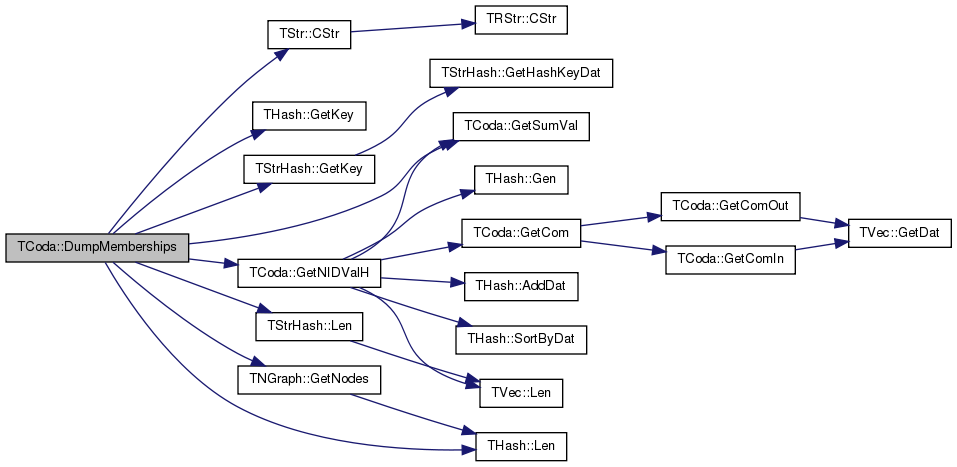
| void TCoda::DumpMemberships | ( | const TStr & | OutFNm, |
| const double | Thres | ||
| ) |
Definition at line 668 of file agmdirected.cpp.
References TStrHash< TDat, TStringPool, THashFunc >::AddKey(), DumpMemberships(), TStr::Fmt(), G, TNGraph::GetNodes(), TVec< TVal, TSizeTy >::Len(), and NIDV.
{
TStrHash<TInt> NodeNameH(G->GetNodes(), false);
for (int u = 0; u < NIDV.Len(); u++) { NodeNameH.AddKey(TStr::Fmt("%d", NIDV[u].Val)); }
DumpMemberships(OutFNm, NodeNameH, Thres);
}
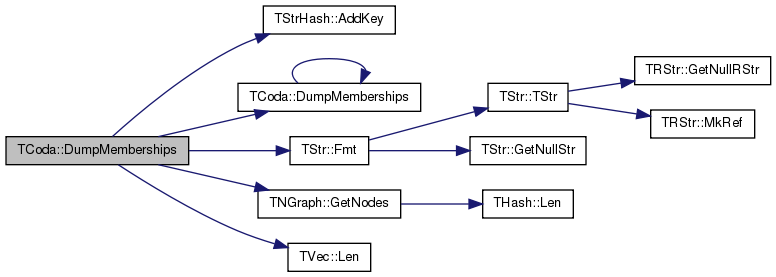
| void TCoda::DumpMemberships | ( | const TStr & | OutFNm | ) | [inline] |
Definition at line 49 of file agmdirected.h.
References DumpMemberships(), and PNoCom.
Referenced by DumpMemberships().
{ DumpMemberships(OutFNm, sqrt(PNoCom)); }


| int TCoda::FindComsByCV | ( | TIntV & | ComsV, |
| const double | HOFrac = 0.2, |
||
| const int | NumThreads = 20, |
||
| const TStr | PlotLFNm = TStr(), |
||
| const int | EdgesForCV = 100, |
||
| const double | StepAlpha = 0.3, |
||
| const double | StepBeta = 0.1 |
||
| ) |
Definition at line 746 of file agmdirected.cpp.
References TVec< TVal, TSizeTy >::Add(), TStr::Empty(), G, TVec< TVal, TSizeTy >::Gen(), TAGMFastUtil::GenHoldOutPairs(), TNGraph::GetNodes(), HOVIDSV, TVec< TVal, TSizeTy >::Last(), TVec< TVal, TSizeTy >::Len(), Likelihood(), LikelihoodHoldOut(), MLEGradAscent(), MLEGradAscentParallel(), TFlt::Mn, NeighborComInit(), TGnuPlot::PlotValV(), RandomInit(), and Rnd.
Referenced by FindComsByCV().
{
if (ComsV.Len() == 0) {
int MaxComs = G->GetNodes() / 5;
ComsV.Add(2);
while(ComsV.Last() < MaxComs) { ComsV.Add(ComsV.Last() * 2); }
}
int MaxIterCV = 3;
TVec<TVec<TIntSet> > HoldOutSets(MaxIterCV);
TFltIntPrV NIdPhiV;
TAGMFastUtil::GetNIdPhiV<PNGraph>(G, NIdPhiV);
if (G->GetEdges() > EdgesForCV) { //if edges are many enough, use CV
printf("generating hold out set\n");
TIntV NIdV1, NIdV2;
G->GetNIdV(NIdV1);
G->GetNIdV(NIdV2);
for (int IterCV = 0; IterCV < MaxIterCV; IterCV++) {
// generate holdout sets
TAGMFastUtil::GenHoldOutPairs(G, HoldOutSets[IterCV], HOFrac, Rnd);
/*
HoldOutSets[IterCV].Gen(G->GetNodes());
const int HOTotal = int(HOFrac * G->GetNodes() * (G->GetNodes() - 1) / 2.0);
int HOCnt = 0;
int HOEdges = (int) TMath::Round(HOFrac * G->GetEdges());
printf("holding out %d edges...\n", HOEdges);
for (int he = 0; he < (int) HOEdges; he++) {
HoldOutSets[IterCV][EdgeV[he].Val1].AddKey(EdgeV[he].Val2);
HoldOutSets[IterCV][EdgeV[he].Val2].AddKey(EdgeV[he].Val1);
HOCnt++;
}
printf("%d Edges hold out\n", HOCnt);
while(HOCnt++ < HOTotal) {
int SrcNID = Rnd.GetUniDevInt(G->GetNodes());
int DstNID = Rnd.GetUniDevInt(G->GetNodes());
HoldOutSets[IterCV][SrcNID].AddKey(DstNID);
HoldOutSets[IterCV][DstNID].AddKey(SrcNID);
}
*/
}
printf("hold out set generated\n");
}
TFltV HOLV(ComsV.Len());
TIntFltPrV ComsLV;
for (int c = 0; c < ComsV.Len(); c++) {
const int Coms = ComsV[c];
printf("Try number of Coms:%d\n", Coms);
if (G->GetEdges() > EdgesForCV) { //if edges are many enough, use CV
for (int IterCV = 0; IterCV < MaxIterCV; IterCV++) {
HOVIDSV = HoldOutSets[IterCV];
NeighborComInit(NIdPhiV, Coms);
printf("Initialized\n");
if (NumThreads == 1) {
printf("MLE without parallelization begins\n");
MLEGradAscent(0.05, 10 * G->GetNodes(), "", StepAlpha, StepBeta);
} else {
printf("MLE with parallelization begins\n");
MLEGradAscentParallel(0.05, 100, NumThreads, "", StepAlpha, StepBeta);
}
double HOL = LikelihoodHoldOut();
HOL = HOL < 0? HOL: TFlt::Mn;
HOLV[c] += HOL;
}
}
else {
HOVIDSV.Gen(G->GetNodes());
MLEGradAscent(0.0001, 100 * G->GetNodes(), "");
double BIC = 2 * Likelihood() - (double) G->GetNodes() * Coms * 2.0 * log ( (double) G->GetNodes());
HOLV[c] = BIC;
}
}
int EstComs = 2;
double MaxL = TFlt::Mn;
printf("\n");
for (int c = 0; c < ComsV.Len(); c++) {
ComsLV.Add(TIntFltPr(ComsV[c].Val, HOLV[c].Val));
printf("%d(%f)\t", ComsV[c].Val, HOLV[c].Val);
if (MaxL < HOLV[c]) {
MaxL = HOLV[c];
EstComs = ComsV[c];
}
}
printf("\n");
RandomInit(EstComs);
HOVIDSV.Gen(G->GetNodes());
if (! PlotLFNm.Empty()) {
TGnuPlot::PlotValV(ComsLV, PlotLFNm, "hold-out likelihood", "communities", "likelihood");
}
return EstComs;
}
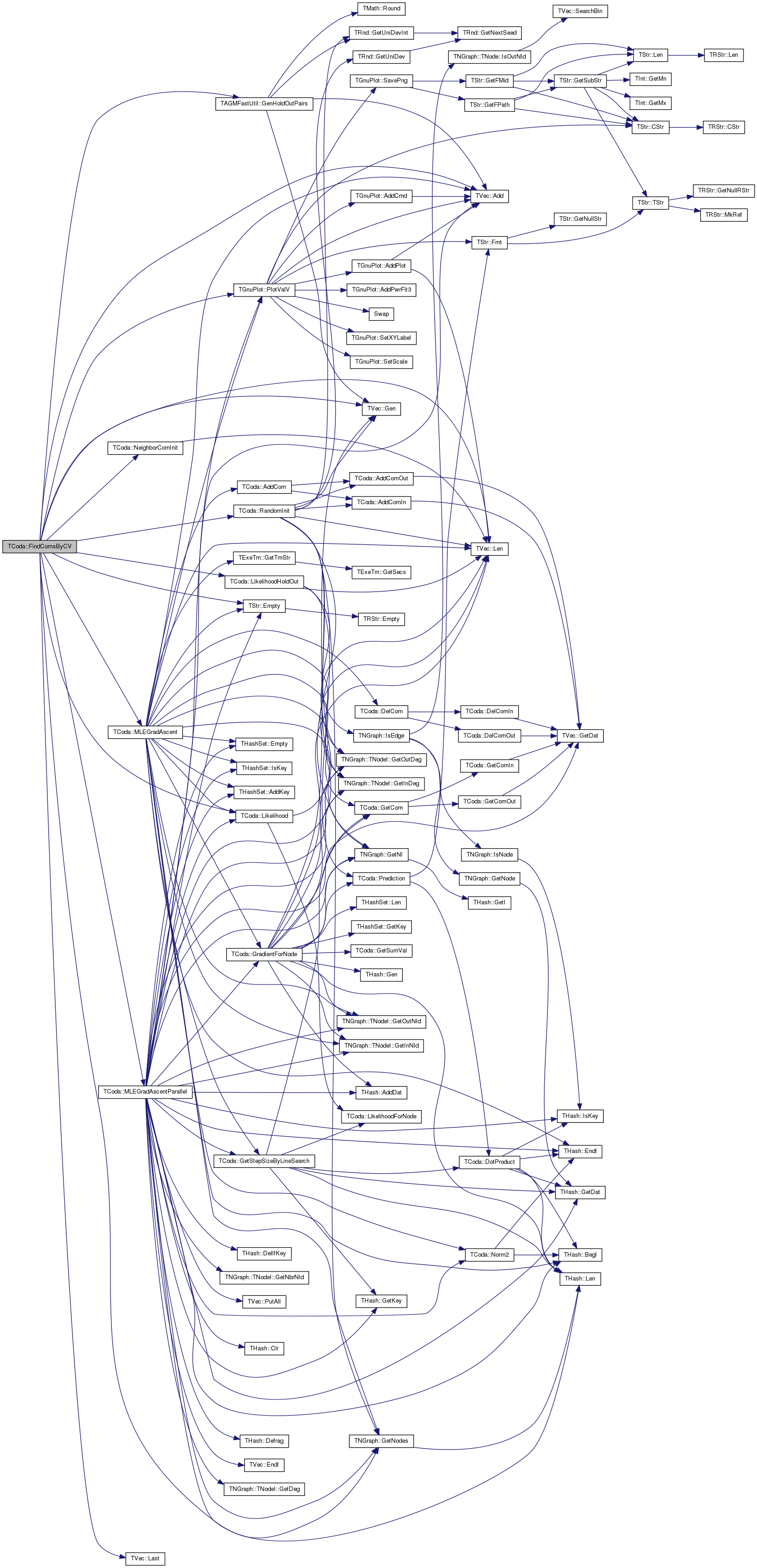

| int TCoda::FindComsByCV | ( | const int | NumThreads, |
| const int | MaxComs, | ||
| const int | MinComs, | ||
| const int | DivComs, | ||
| const TStr | OutFNm, | ||
| const int | EdgesForCV = 100, |
||
| const double | StepAlpha = 0.3, |
||
| const double | StepBeta = 0.3 |
||
| ) |
estimate number of communities using cross validation
Definition at line 733 of file agmdirected.cpp.
References TVec< TVal, TSizeTy >::Add(), FindComsByCV(), TVec< TVal, TSizeTy >::Last(), TVec< TVal, TSizeTy >::Len(), TMath::Log(), and TInt::Val.
{
double ComsGap = exp(TMath::Log((double) MaxComs / (double) MinComs) / (double) DivComs);
TIntV ComsV;
ComsV.Add(MinComs);
while (ComsV.Len() < DivComs) {
int NewComs = int(ComsV.Last() * ComsGap);
if (NewComs == ComsV.Last().Val) { NewComs++; }
ComsV.Add(NewComs);
}
if (ComsV.Last() < MaxComs) { ComsV.Add(MaxComs); }
return FindComsByCV(ComsV, 0.1, NumThreads, OutFNm, EdgesForCV, StepAlpha, StepBeta);
}
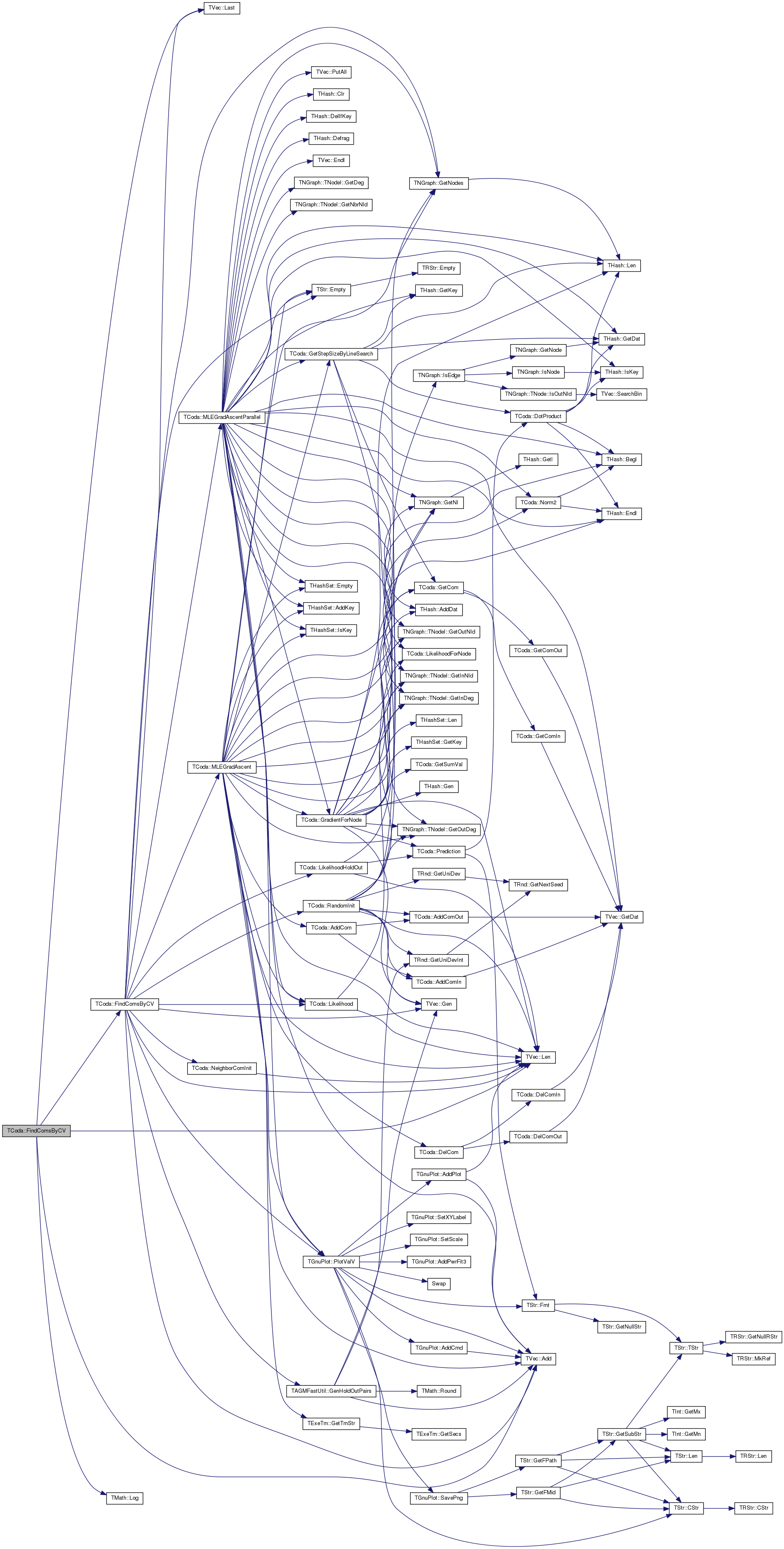
| void TCoda::GetCmtyS | ( | TIntSet & | CmtySOut, |
| TIntSet & | CmtySIn, | ||
| const int | CID, | ||
| const double | Thres | ||
| ) |
Definition at line 674 of file agmdirected.cpp.
References G, THashSet< TKey, THashFunc >::Gen(), GetCom(), TNGraph::GetNodes(), TVec< TVal, TSizeTy >::Len(), and NIDV.
{
CmtySOut.Gen(G->GetNodes() / 10);
CmtySIn.Gen(G->GetNodes() / 10);
for (int u = 0; u < NIDV.Len(); u++) {
if (GetCom(true, u, CID) > Thres) {
//CmtySOut.AddKey(
}
}
}

| void TCoda::GetCmtyVV | ( | TVec< TIntV > & | CmtyVVOut, |
| TVec< TIntV > & | CmtyVVIn, | ||
| const int | MinSz = 3 |
||
| ) |
Definition at line 717 of file agmdirected.cpp.
References G, and TNGraph::GetNodes().
Referenced by GetCmtyVV().
{
GetCmtyVV(false, CmtyVVIn, sqrt(1.0 / G->GetNodes()), MinSz);
GetCmtyVV(true, CmtyVVOut, sqrt(1.0 / G->GetNodes()), MinSz);
}


| void TCoda::GetCmtyVV | ( | TVec< TIntV > & | CmtyVVOut, |
| TVec< TIntV > & | CmtyVVIn, | ||
| const double | ThresOut, | ||
| const double | ThresIn, | ||
| const int | MinSz = 3 |
||
| ) |
Definition at line 727 of file agmdirected.cpp.
References GetCmtyVV().

| void TCoda::GetCmtyVV | ( | const bool | IsOut, |
| TVec< TIntV > & | CmtyVV | ||
| ) |
Definition at line 501 of file agmdirected.cpp.
References G, GetCmtyVV(), and TNGraph::GetNodes().

| void TCoda::GetCmtyVV | ( | const bool | IsOut, |
| TVec< TIntV > & | CmtyVV, | ||
| const double | Thres, | ||
| const int | MinSz = 3 |
||
| ) |
extract community affiliation for outgoing edges from F_uc
Definition at line 539 of file agmdirected.cpp.
References TVec< TVal, TSizeTy >::Add(), THash< TKey, TDat, THashFunc >::AddDat(), TVec< TVal, TSizeTy >::Gen(), THash< TKey, TDat, THashFunc >::GetKey(), THash< TKey, TDat, THashFunc >::GetKeyV(), GetNIDValH(), GetSumVal(), TVec< TVal, TSizeTy >::Len(), NumComs, and THash< TKey, TDat, THashFunc >::SortByDat().
{
CmtyVV.Gen(NumComs, 0);
TIntFltH CIDSumFH(NumComs);
for (int c = 0; c < NumComs; c++) {
CIDSumFH.AddDat(c, GetSumVal(IsOut, c));
}
CIDSumFH.SortByDat(false);
for (int c = 0; c < NumComs; c++) {
int CID = CIDSumFH.GetKey(c);
TIntFltH NIDFucH, NIDHucH, NIDInOutH;
TIntV CmtyV;
GetNIDValH(NIDInOutH, NIDFucH, NIDHucH, CID, Thres);
if (IsOut) {
NIDFucH.GetKeyV(CmtyV);
} else {
NIDHucH.GetKeyV(CmtyV);
}
if (CmtyV.Len() >= MinSz) { CmtyVV.Add(CmtyV); }
}
if ( NumComs != CmtyVV.Len()) {
printf("Community vector generated. %d communities are ommitted\n", NumComs.Val - CmtyVV.Len());
}
}
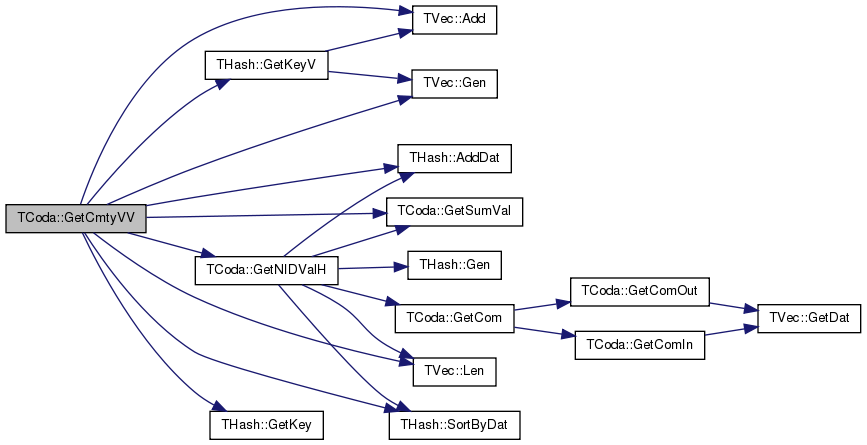
| void TCoda::GetCmtyVVUnSorted | ( | const bool | IsOut, |
| TVec< TIntV > & | CmtyVV, | ||
| const double | Thres, | ||
| const int | MinSz = 3 |
||
| ) |
Definition at line 563 of file agmdirected.cpp.
References TVec< TVal, TSizeTy >::Add(), G, TVec< TVal, TSizeTy >::Gen(), GetCom(), TNGraph::GetNodes(), GetSumVal(), TVec< TVal, TSizeTy >::Len(), NIDV, and NumComs.
Referenced by GetCmtyVVUnSorted().
{
CmtyVV.Gen(NumComs, 0);
for (int c = 0; c < NumComs; c++) {
TIntV CmtyV((int) (GetSumVal(IsOut, c) * 10), 0);
for (int u = 0; u < G->GetNodes(); u++) {
if (GetCom(IsOut, u, c) > Thres) { CmtyV.Add(NIDV[u]); }
}
if (CmtyV.Len() >= MinSz) { CmtyVV.Add(CmtyV); }
}
if ( NumComs != CmtyVV.Len()) {
printf("Community vector generated. %d communities are ommitted\n", NumComs.Val - CmtyVV.Len());
}
}
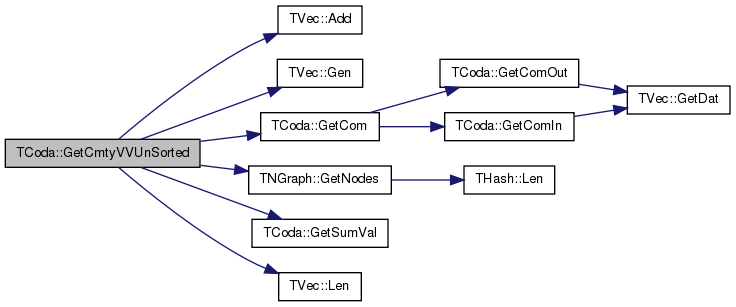

| void TCoda::GetCmtyVVUnSorted | ( | TVec< TIntV > & | CmtyVVOut, |
| TVec< TIntV > & | CmtyVVIn | ||
| ) |
Definition at line 722 of file agmdirected.cpp.
References G, GetCmtyVVUnSorted(), and TNGraph::GetNodes().
{
GetCmtyVVUnSorted(false, CmtyVVIn, sqrt(1.0 / G->GetNodes()));
GetCmtyVVUnSorted(true, CmtyVVOut, sqrt(1.0 / G->GetNodes()));
}

| double TCoda::GetCom | ( | const bool | IsOut, |
| const int & | NID, | ||
| const int & | CID | ||
| ) | [inline] |
Definition at line 93 of file agmdirected.h.
References GetComIn(), and GetComOut().
Referenced by GetCmtyS(), GetCmtyVVUnSorted(), GetCommunity(), GetNIDValH(), GetStepSizeByLineSearch(), GradientForNode(), LikelihoodForNode(), and MLEGradAscent().

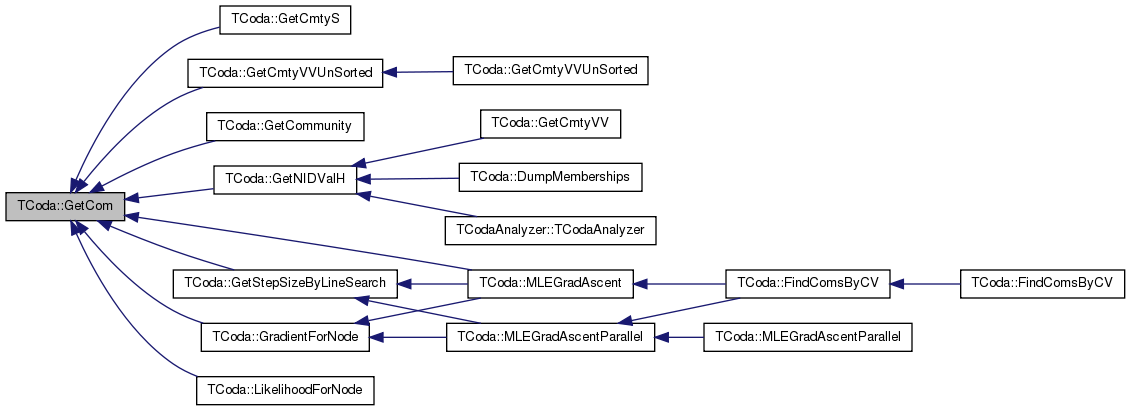
| double TCoda::GetComIn | ( | const int & | NID, |
| const int & | CID | ||
| ) | [inline] |
Definition at line 107 of file agmdirected.h.
References TVec< TVal, TSizeTy >::GetDat(), and H.
Referenced by GetCom().


| void TCoda::GetCommunity | ( | TIntV & | CmtyVIn, |
| TIntV & | CmtyVOut, | ||
| const int | CID | ||
| ) | [inline] |
Definition at line 50 of file agmdirected.h.
References GetCommunity(), and PNoCom.
Referenced by GetCommunity(), and GetTopCIDs().
{ GetCommunity(CmtyVIn, CmtyVOut, CID, sqrt(PNoCom)); }


| void TCoda::GetCommunity | ( | TIntV & | CmtyVIn, |
| TIntV & | CmtyVOut, | ||
| const int | CID, | ||
| const double | Thres | ||
| ) |
extract community affiliation for given community ID
Definition at line 506 of file agmdirected.cpp.
References F, GetCom(), TVec< TVal, TSizeTy >::Len(), NIDV, and NodesOk.
{
TIntFltH NIDFucH(F.Len() / 10), NIDHucH(F.Len() / 10);
for (int u = 0; u < NIDV.Len(); u++) {
int NID = u;
if (! NodesOk) { NID = NIDV[u]; }
if (GetCom(true, u, CID) >= Thres) { NIDFucH.AddDat(NID, GetCom(true, u, CID)); }
if (GetCom(false, u, CID) >= Thres) { NIDHucH.AddDat(NID, GetCom(false, u, CID)); }
}
NIDFucH.SortByDat(false);
NIDHucH.SortByDat(false);
NIDFucH.GetKeyV(CmtyVOut);
NIDHucH.GetKeyV(CmtyVIn);
}

| double TCoda::GetComOut | ( | const int & | NID, |
| const int & | CID | ||
| ) | [inline] |
Definition at line 100 of file agmdirected.h.
References F, and TVec< TVal, TSizeTy >::GetDat().
Referenced by GetCom().


| PNGraph TCoda::GetGraph | ( | ) | [inline] |
Definition at line 577 of file agmdirected.cpp.
References TNGraph::AddEdge(), TNGraph::AddNode(), TNGraph::BegNI(), TNGraph::EndNI(), G, TNGraph::GetEdges(), TNGraph::GetNodes(), IAssert, TNGraph::IsNode(), TNGraph::New(), and NIDV.
Referenced by TCodaAnalyzer::TCodaAnalyzer().
{
PNGraph NewG = TNGraph::New(G->GetNodes(), -1);
for (TNGraph::TNodeI NI = G->BegNI(); NI < G->EndNI(); NI++) {
//add node
int NIdx = NI.GetId();
int NID = NIDV[NIdx];
if (! NewG->IsNode(NID)) { NewG->AddNode(NID); }
//add edge
for (int e = 0; e < NI.GetOutDeg(); e++) {
int OutNID = NIDV[NI.GetOutNId(e)];
if (! NewG->IsNode(OutNID)) { NewG->AddNode(OutNID); }
NewG->AddEdge(NID, OutNID);
}
}
IAssert(G->GetNodes() == NewG->GetNodes());
IAssert(G->GetEdges() == NewG->GetEdges());
return NewG;
}
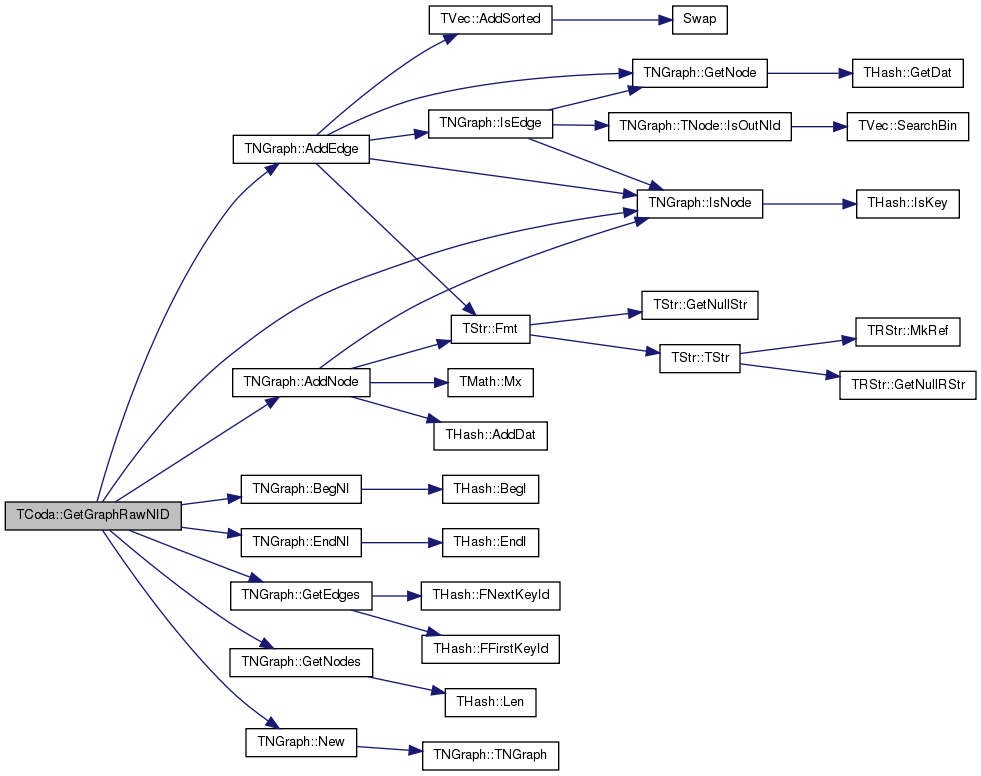

| void TCoda::GetNIDValH | ( | TIntFltH & | NIdValInOutH, |
| TIntFltH & | NIdValOutH, | ||
| TIntFltH & | NIdValInH, | ||
| const int | CID, | ||
| const double | Thres | ||
| ) |
Definition at line 596 of file agmdirected.cpp.
References THash< TKey, TDat, THashFunc >::AddDat(), THash< TKey, TDat, THashFunc >::Gen(), GetCom(), GetSumVal(), TVec< TVal, TSizeTy >::Len(), NIDV, and THash< TKey, TDat, THashFunc >::SortByDat().
Referenced by DumpMemberships(), GetCmtyVV(), and TCodaAnalyzer::TCodaAnalyzer().
{
NIdValOutH.Gen((int) GetSumVal(true, CID) + 1);
NIdValInH.Gen((int) GetSumVal(false, CID) + 1);
NIdValInOutH.Gen((int) GetSumVal(false, CID) + 1);
if (GetSumVal(true, CID) < Thres && GetSumVal(false, CID) < Thres) { return; }
for (int u = 0; u < NIDV.Len(); u++) {
if (GetCom(true, u, CID) >= Thres && GetCom(false, u, CID) >= Thres) {
NIdValInOutH.AddDat(NIDV[u], GetCom(true, u, CID) + GetCom(false, u, CID));
}
if (GetCom(true, u, CID) >= Thres) {
NIdValOutH.AddDat(NIDV[u], GetCom(true, u, CID));
}
if (GetCom(false, u, CID) >= Thres) {
NIdValInH.AddDat(NIDV[u], GetCom(false, u, CID));
}
}
NIdValInH.SortByDat(false);
NIdValOutH.SortByDat(false);
NIdValInOutH.SortByDat(false);
}
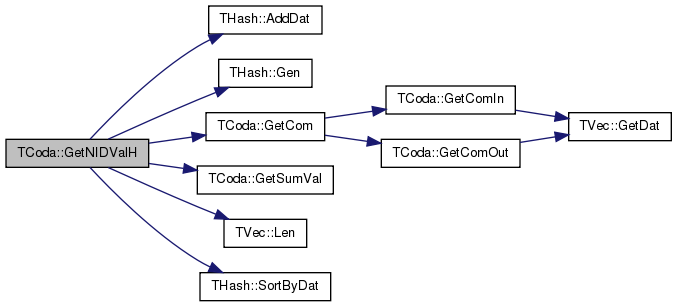
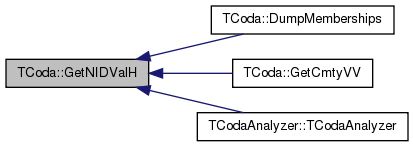
| void TCoda::GetNonEdgePairScores | ( | TFltIntIntTrV & | ScoreV | ) |
Definition at line 153 of file agmdirected.cpp.
References TVec< TVal, TSizeTy >::Add(), G, TVec< TVal, TSizeTy >::Gen(), TNGraph::GetNIdV(), TNGraph::GetNodes(), TNGraph::IsEdge(), TVec< TVal, TSizeTy >::Len(), NIDV, and Prediction().
{
ScoreV.Gen(G->GetNodes() * G->GetNodes(), 0);
TIntV NIDV;
G->GetNIdV(NIDV);
TIntSet Cuv;
for (int u = 0; u < NIDV.Len(); u++) {
int UID = NIDV[u];
for (int v = 0; v < NIDV.Len(); v++) {
int VID = NIDV[v];
if (UID == VID) { continue; }
if (! G->IsEdge(UID, VID)) {
double Val = 1.0 - Prediction(UID, VID);
ScoreV.Add(TFltIntIntTr(Val, UID, VID));
}
}
}
}
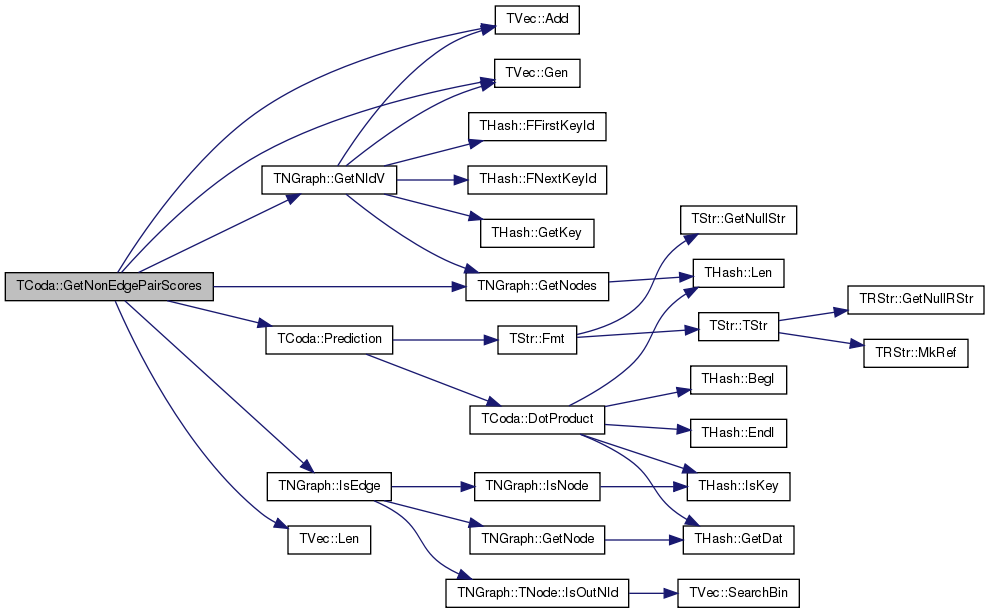
| int TCoda::GetNumComs | ( | ) | [inline] |
Definition at line 36 of file agmdirected.h.
References NumComs, and TInt::Val.
Referenced by GetTopCIDs(), and TCodaAnalyzer::TCodaAnalyzer().

| double TCoda::GetRegCoef | ( | ) | [inline] |
| double TCoda::GetStepSizeByLineSearch | ( | const bool | IsRow, |
| const int | UID, | ||
| const TIntFltH & | DeltaV, | ||
| const TIntFltH & | GradV, | ||
| const double & | Alpha, | ||
| const double & | Beta, | ||
| const int | MaxIter = 10 |
||
| ) |
Definition at line 859 of file agmdirected.cpp.
References DotProduct(), GetCom(), THash< TKey, TDat, THashFunc >::GetDat(), THash< TKey, TDat, THashFunc >::GetKey(), THash< TKey, TDat, THashFunc >::Len(), LikelihoodForNode(), MaxVal, and MinVal.
Referenced by MLEGradAscent(), and MLEGradAscentParallel().
{
double StepSize = 1.0;
double InitLikelihood = LikelihoodForNode(IsRow, UID);
TIntFltH NewVarV(DeltaV.Len());
for(int iter = 0; iter < MaxIter; iter++) {
for (int i = 0; i < DeltaV.Len(); i++){
int CID = DeltaV.GetKey(i);
double NewVal;
NewVal = GetCom(IsRow, UID, CID) + StepSize * DeltaV.GetDat(CID);
if (NewVal < MinVal) { NewVal = MinVal; }
if (NewVal > MaxVal) { NewVal = MaxVal; }
NewVarV.AddDat(CID, NewVal);
}
if (LikelihoodForNode(IsRow, UID, NewVarV) < InitLikelihood + Alpha * StepSize * DotProduct(GradV, DeltaV)) {
StepSize *= Beta;
} else {
break;
}
if (iter == MaxIter - 1) {
StepSize = 0.0;
break;
}
}
return StepSize;
}
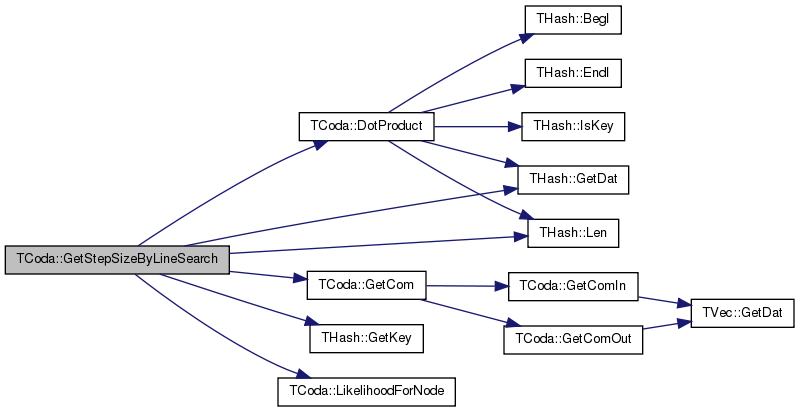

| TFlt& TCoda::GetSumVal | ( | const bool | IsOut, |
| const int | CID | ||
| ) | [inline] |
Definition at line 86 of file agmdirected.h.
Referenced by DumpMemberships(), GetCmtyVV(), GetCmtyVVUnSorted(), GetNIDValH(), GetTopCIDs(), GradientForNode(), and LikelihoodForNode().

| void TCoda::GetTopCIDs | ( | TIntV & | CIdV, |
| const int | TopK, | ||
| const int | IsAverage = 1, |
||
| const int | MinSz = 1 |
||
| ) |
Definition at line 520 of file agmdirected.cpp.
References THash< TKey, TDat, THashFunc >::AddDat(), GetCommunity(), THash< TKey, TDat, THashFunc >::GetKeyV(), GetNumComs(), GetSumVal(), THash< TKey, TDat, THashFunc >::Len(), TVec< TVal, TSizeTy >::Len(), THash< TKey, TDat, THashFunc >::SortByDat(), and TVec< TVal, TSizeTy >::Trunc().
Referenced by TCodaAnalyzer::TCodaAnalyzer().
{
TIntFltH CIdFHH;
for (int c = 0; c < GetNumComs(); c++) {
if (IsAverage == 1) {
TIntV CmtyVIn, CmtyVOut;
GetCommunity(CmtyVIn, CmtyVOut, c);
if (CmtyVIn.Len() == 0 || CmtyVOut.Len() == 0) { continue; }
if (CmtyVIn.Len() < MinSz || CmtyVOut.Len() < MinSz) { continue; }
CIdFHH.AddDat(c, GetSumVal(true, c) * GetSumVal(false, c) / (double) CmtyVIn.Len() / (double) CmtyVOut.Len());
} else {
CIdFHH.AddDat(c, GetSumVal(true, c) * GetSumVal(false, c));
}
}
CIdFHH.SortByDat(false);
CIdFHH.GetKeyV(CIdV);
if (TopK < CIdFHH.Len()) { CIdV.Trunc(TopK); }
}
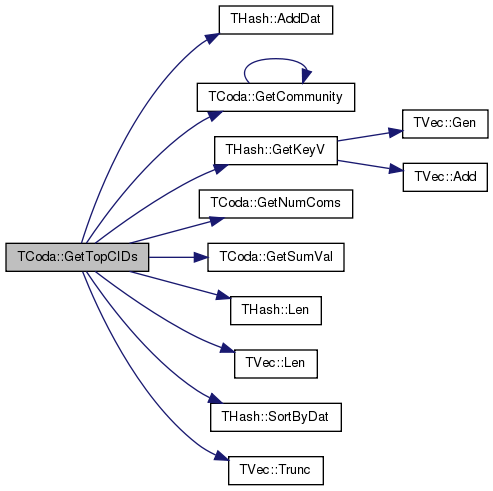

| void TCoda::GradientForNode | ( | const bool | IsRow, |
| const int | UID, | ||
| TIntFltH & | GradU, | ||
| const TIntSet & | CIDSet | ||
| ) |
Definition at line 377 of file agmdirected.cpp.
References THash< TKey, TDat, THashFunc >::AddDat(), G, THash< TKey, TDat, THashFunc >::Gen(), TVec< TVal, TSizeTy >::Gen(), GetCom(), TNGraph::TNodeI::GetInDeg(), TNGraph::TNodeI::GetInNId(), THashSet< TKey, THashFunc >::GetKey(), TNGraph::GetNI(), TNGraph::TNodeI::GetOutDeg(), TNGraph::TNodeI::GetOutNId(), GetSumVal(), HOVIDSV, IAssert, THash< TKey, TDat, THashFunc >::Len(), TVec< TVal, TSizeTy >::Len(), THashSet< TKey, THashFunc >::Len(), NegWgt, NumComs, Prediction(), RegCoef, and SumHV.
Referenced by MLEGradAscent(), and MLEGradAscentParallel().
{
GradU.Gen(CIDSet.Len());
TFltV HOSumHV; //adjust for Hv of v hold out
if (HOVIDSV[UID].Len() > 0) {
HOSumHV.Gen(NumComs);
for (int e = 0; e < HOVIDSV[UID].Len(); e++) {
for (int c = 0; c < SumHV.Len(); c++) {
HOSumHV[c] += GetCom(! IsRow, HOVIDSV[UID][e], c);
}
}
}
TNGraph::TNodeI NI = G->GetNI(UID);
int Deg = IsRow ? NI.GetOutDeg(): NI.GetInDeg();
TFltV PredV(Deg), GradV(CIDSet.Len());
TIntV CIDV(CIDSet.Len());
for (int e = 0; e < Deg; e++) {
int VID = IsRow? NI.GetOutNId(e): NI.GetInNId(e);
if (VID == UID) { continue; }
if (HOVIDSV[UID].IsKey(VID)) { continue; }
PredV[e] = IsRow? Prediction(UID, VID): Prediction(VID, UID);
}
for (int c = 0; c < CIDSet.Len(); c++) {
int CID = CIDSet.GetKey(c);
double Val = 0.0;
for (int e = 0; e < Deg; e++) {
int VID = IsRow? NI.GetOutNId(e): NI.GetInNId(e);
if (VID == UID) { continue; }
if (HOVIDSV[UID].IsKey(VID)) { continue; }
Val += PredV[e] * GetCom(! IsRow, VID, CID) / (1.0 - PredV[e]) + NegWgt * GetCom(! IsRow, VID, CID);
}
double HOSum = HOVIDSV[UID].Len() > 0? HOSumHV[CID].Val: 0.0;//subtract Hold out pairs only if hold out pairs exist
Val -= NegWgt * (GetSumVal(! IsRow, CID) - HOSum - GetCom(! IsRow, UID, CID));
CIDV[c] = CID;
GradV[c] = Val;
}
//add regularization
if (RegCoef > 0.0) { //L1
for (int c = 0; c < GradV.Len(); c++) {
GradV[c] -= RegCoef;
}
}
if (RegCoef < 0.0) { //L2
for (int c = 0; c < GradV.Len(); c++) {
GradV[c] += 2 * RegCoef * GetCom(IsRow, UID, CIDV[c]);
}
}
for (int c = 0; c < GradV.Len(); c++) {
if (GetCom(IsRow, UID, CIDV[c]) == 0.0 && GradV[c] < 0.0) { continue; }
if (fabs(GradV[c]) < 0.0001) { continue; }
GradU.AddDat(CIDV[c], GradV[c]);
}
for (int c = 0; c < GradU.Len(); c++) {
if (GradU[c] >= 10) { GradU[c] = 10; }
if (GradU[c] <= -10) { GradU[c] = -10; }
IAssert(GradU[c] >= -10);
}
}
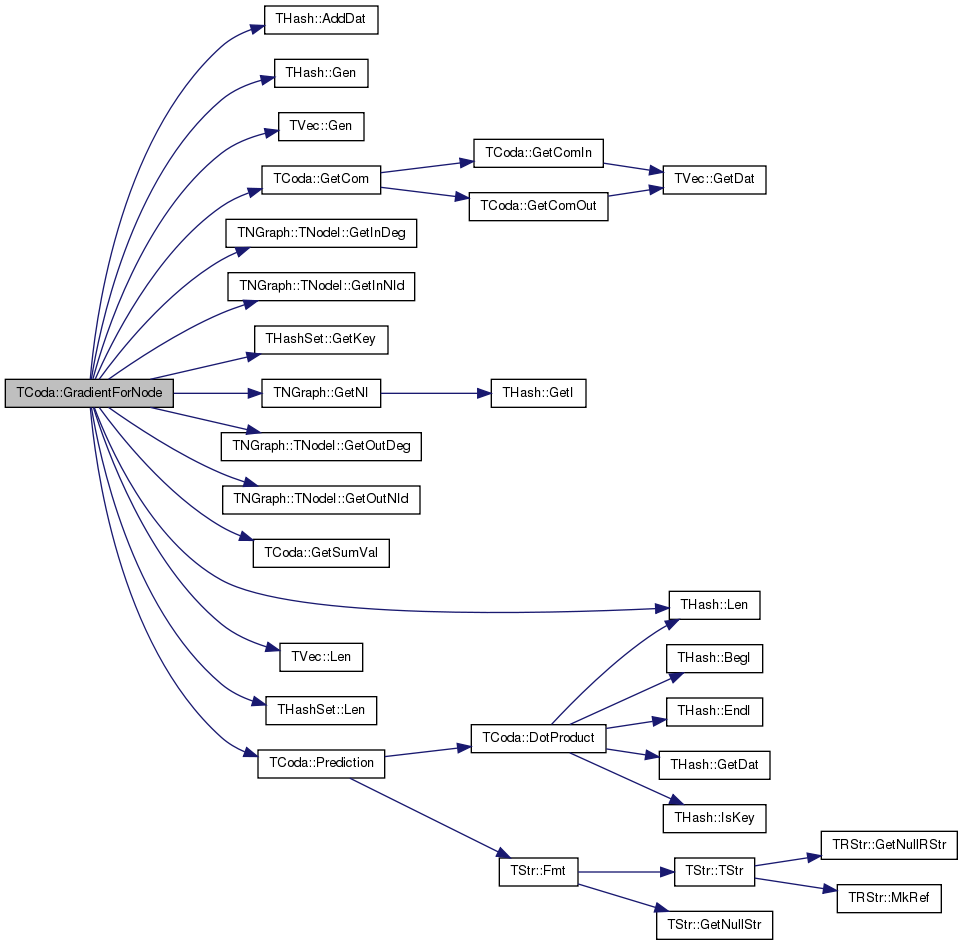

| double TCoda::Likelihood | ( | const bool | DoParallel = false | ) |
Definition at line 231 of file agmdirected.cpp.
References F, TVec< TVal, TSizeTy >::Len(), and LikelihoodForNode().
Referenced by FindComsByCV(), MLEGradAscent(), and MLEGradAscentParallel().
{
TExeTm ExeTm;
double L = 0.0;
if (_DoParallel) {
#pragma omp parallel for
for (int u = 0; u < F.Len(); u++) {
double LU = LikelihoodForNode(true, u);
#pragma omp atomic
L += LU;
}
}
else {
for (int u = 0; u < F.Len(); u++) {
double LU = LikelihoodForNode(true, u);
L += LU;
}
}
return L;
}


| double TCoda::LikelihoodForNode | ( | const bool | IsRow, |
| const int | UID | ||
| ) |
Definition at line 251 of file agmdirected.cpp.
Referenced by GetStepSizeByLineSearch(), and Likelihood().
{
if (IsRow) {
return LikelihoodForNode(IsRow, UID, F[UID]);
} else {
return LikelihoodForNode(IsRow, UID, H[UID]);
}
}

| double TCoda::LikelihoodForNode | ( | const bool | IsRow, |
| const int | UID, | ||
| const TIntFltH & | FU | ||
| ) |
Definition at line 259 of file agmdirected.cpp.
References THash< TKey, TDat, THashFunc >::BegI(), DotProduct(), THash< TKey, TDat, THashFunc >::EndI(), F, G, TVec< TVal, TSizeTy >::Gen(), GetCom(), TNGraph::TNodeI::GetInDeg(), TNGraph::TNodeI::GetInNId(), TNGraph::GetNI(), TNGraph::TNodeI::GetOutDeg(), TNGraph::TNodeI::GetOutNId(), GetSumVal(), H, HOVIDSV, TVec< TVal, TSizeTy >::Len(), NegWgt, Norm2(), NumComs, Prediction(), RegCoef, Sum(), and SumHV.
{
double L = 0.0;
TFltV HOSumHV; //adjust for Hv of v hold out
if (HOVIDSV[UID].Len() > 0) {
HOSumHV.Gen(NumComs);
for (int e = 0; e < HOVIDSV[UID].Len(); e++) {
for (int c = 0; c < SumHV.Len(); c++) {
HOSumHV[c] += GetCom(! IsRow, HOVIDSV[UID][e], c);
}
}
}
TNGraph::TNodeI NI = G->GetNI(UID);
const int Deg = IsRow ? NI.GetOutDeg(): NI.GetInDeg();
for (int e = 0; e < Deg; e++) {
const int v = IsRow ? NI.GetOutNId(e): NI.GetInNId(e);
if (v == UID) { continue; }
if (HOVIDSV[UID].IsKey(v)) { continue; }
if (IsRow) {
L += log (1.0 - Prediction(FU, H[v])) + NegWgt * DotProduct(FU, H[v]);
} else {
L += log (1.0 - Prediction(F[v], FU)) + NegWgt * DotProduct(F[v], FU);
}
}
for (TIntFltH::TIter HI = FU.BegI(); HI < FU.EndI(); HI++) {
double HOSum = HOVIDSV[UID].Len() > 0? HOSumHV[HI.GetKey()].Val: 0.0;//subtract Hold out pairs only if hold out pairs exist
L -= NegWgt * (GetSumVal(! IsRow, HI.GetKey()) - HOSum - GetCom(! IsRow, UID, HI.GetKey())) * HI.GetDat();
}
//add regularization
if (RegCoef > 0.0) { //L1
L -= RegCoef * Sum(FU);
}
if (RegCoef < 0.0) { //L2
L += RegCoef * Norm2(FU);
}
return L;
}
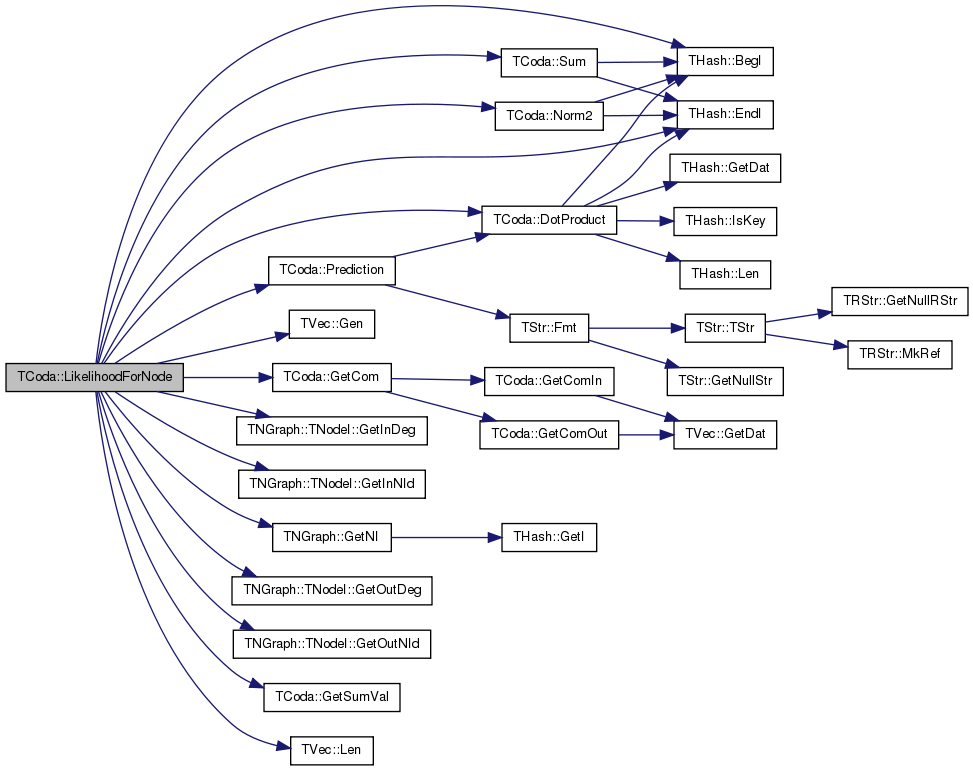
| double TCoda::LikelihoodHoldOut | ( | const bool | DoParallel = false | ) |
Definition at line 841 of file agmdirected.cpp.
References G, HOVIDSV, TNGraph::IsEdge(), TVec< TVal, TSizeTy >::Len(), NegWgt, and Prediction().
Referenced by FindComsByCV().
{
double L = 0.0;
for (int u = 0; u < HOVIDSV.Len(); u++) {
for (int e = 0; e < HOVIDSV[u].Len(); e++) {
int VID = HOVIDSV[u][e];
if (VID == u) { continue; }
double Pred = Prediction(u, VID);
if (G->IsEdge(u, VID)) {
L += log(1.0 - Pred);
}
else {
L += NegWgt * log(Pred);
}
}
}
return L;
}
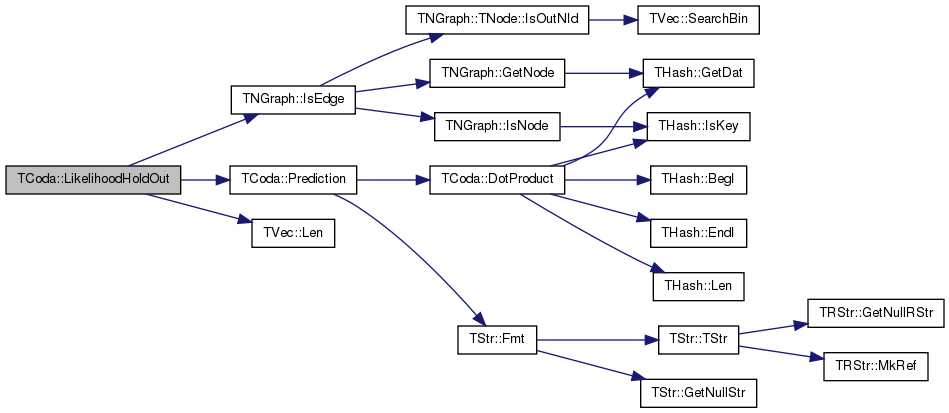

| void TCoda::Load | ( | TSIn & | SIn, |
| const int & | RndSeed = 0 |
||
| ) |
Definition at line 25 of file agmdirected.cpp.
References F, G, H, HOVIDSV, TNGraph::Load(), TVec< TVal, TSizeTy >::Load(), TBool::Load(), TInt::Load(), TFlt::Load(), MaxVal, MinVal, NegWgt, NIDV, NodesOk, NumComs, PNoCom, TRnd::PutSeed(), RegCoef, Rnd, SumFV, and SumHV.
{
G->Load(SIn);
F.Load(SIn);
H.Load(SIn);
NIDV.Load(SIn);
RegCoef.Load(SIn);
SumFV.Load(SIn);
SumHV.Load(SIn);
NodesOk.Load(SIn);
MinVal.Load(SIn);
MaxVal.Load(SIn);
NegWgt.Load(SIn);
NumComs.Load(SIn);
HOVIDSV.Load(SIn);
PNoCom.Load(SIn);
Rnd.PutSeed(RndSeed);
}
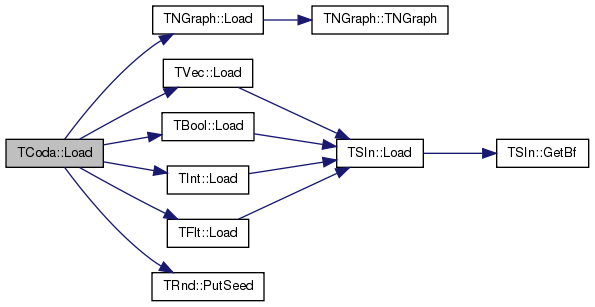
| int TCoda::MLEGradAscent | ( | const double & | Thres, |
| const int & | MaxIter, | ||
| const TStr | PlotNm, | ||
| const double | StepAlpha = 0.3, |
||
| const double | StepBeta = 0.1 |
||
| ) |
Definition at line 885 of file agmdirected.cpp.
References TVec< TVal, TSizeTy >::Add(), AddCom(), THashSet< TKey, THashFunc >::AddKey(), THash< TKey, TDat, THashFunc >::BegI(), DelCom(), TStr::Empty(), THashSet< TKey, THashFunc >::Empty(), THash< TKey, TDat, THashFunc >::EndI(), F, G, GetCom(), TNGraph::TNodeI::GetInDeg(), TNGraph::TNodeI::GetInNId(), TNGraph::GetNI(), TNGraph::GetNodes(), TNGraph::TNodeI::GetOutDeg(), TNGraph::TNodeI::GetOutNId(), GetStepSizeByLineSearch(), TExeTm::GetTmStr(), GradientForNode(), H, HOVIDSV, IAssert, THashSet< TKey, THashFunc >::IsKey(), TVec< TVal, TSizeTy >::Len(), Likelihood(), TFlt::Mn, Norm2(), NumComs, TGnuPlot::PlotValV(), and Rnd.
Referenced by FindComsByCV().
{
time_t InitTime = time(NULL);
TExeTm ExeTm, CheckTm;
int iter = 0, PrevIter = 0;
TIntFltPrV IterLV;
TNGraph::TNodeI UI;
double PrevL = TFlt::Mn, CurL = 0.0;
TIntV NIdxV(F.Len(), 0);
for (int i = 0; i < F.Len(); i++) { NIdxV.Add(i); }
IAssert(NIdxV.Len() == F.Len());
TIntFltH GradV;
while(iter < MaxIter) {
NIdxV.Shuffle(Rnd);
for (int ui = 0; ui < F.Len(); ui++, iter++) {
const bool IsRow = (ui % 2 == 0);
int u = NIdxV[ui]; //
//find set of candidate c (we only need to consider c to which a neighbor of u belongs to)
UI = G->GetNI(u);
const int Deg = IsRow? UI.GetOutDeg(): UI.GetInDeg();
TIntSet CIDSet(5 * Deg);
for (int e = 0; e < Deg; e++) {
int VID = IsRow? UI.GetOutNId(e): UI.GetInNId(e);
if (HOVIDSV[u].IsKey(VID)) { continue; }
TIntFltH NbhCIDH = IsRow? H[VID]: F[VID];
for (TIntFltH::TIter CI = NbhCIDH.BegI(); CI < NbhCIDH.EndI(); CI++) {
CIDSet.AddKey(CI.GetKey());
//printf("CI.GetKey:%d\n", CI.GetKey());
IAssert(CI.GetKey() <= NumComs);
}
}
TIntFltH& CurMem = IsRow? F[u]: H[u];
for (TIntFltH::TIter CI = CurMem.BegI(); CI < CurMem.EndI(); CI++) { //remove the community membership which U does not share with its neighbors
if (! CIDSet.IsKey(CI.GetKey())) {
DelCom(IsRow, u, CI.GetKey());
}
}
if (CIDSet.Empty()) { continue; }
GradientForNode(IsRow, u, GradV, CIDSet);
if (Norm2(GradV) < 1e-4) { continue; }
double LearnRate = GetStepSizeByLineSearch(IsRow, u, GradV, GradV, StepAlpha, StepBeta);
if (LearnRate == 0.0) { continue; }
for (int ci = 0; ci < GradV.Len(); ci++) {
int CID = GradV.GetKey(ci);
double Change = LearnRate * GradV.GetDat(CID);
double NewFuc = GetCom(IsRow, u, CID) + Change;
if (NewFuc <= 0.0) {
DelCom(IsRow, u, CID);
} else {
AddCom(IsRow, u, CID, NewFuc);
}
}
if (! PlotNm.Empty() && (iter + 1) % G->GetNodes() == 0) {
IterLV.Add(TIntFltPr(iter, Likelihood(false)));
}
}
printf("\r%d iterations (%f) [%lu sec]", iter, CurL, time(NULL) - InitTime);
fflush(stdout);
if (iter - PrevIter >= 2 * G->GetNodes() && iter > 10000) {
PrevIter = iter;
CurL = Likelihood();
if (PrevL > TFlt::Mn && ! PlotNm.Empty()) {
printf("\r%d iterations, Likelihood: %f, Diff: %f", iter, CurL, CurL - PrevL);
}
fflush(stdout);
if (CurL - PrevL <= Thres * fabs(PrevL)) { break; }
else { PrevL = CurL; }
}
}
printf("\n");
printf("MLE for Lambda completed with %d iterations(%s)\n", iter, ExeTm.GetTmStr());
if (! PlotNm.Empty()) {
TGnuPlot::PlotValV(IterLV, PlotNm + ".likelihood_Q");
}
return iter;
}
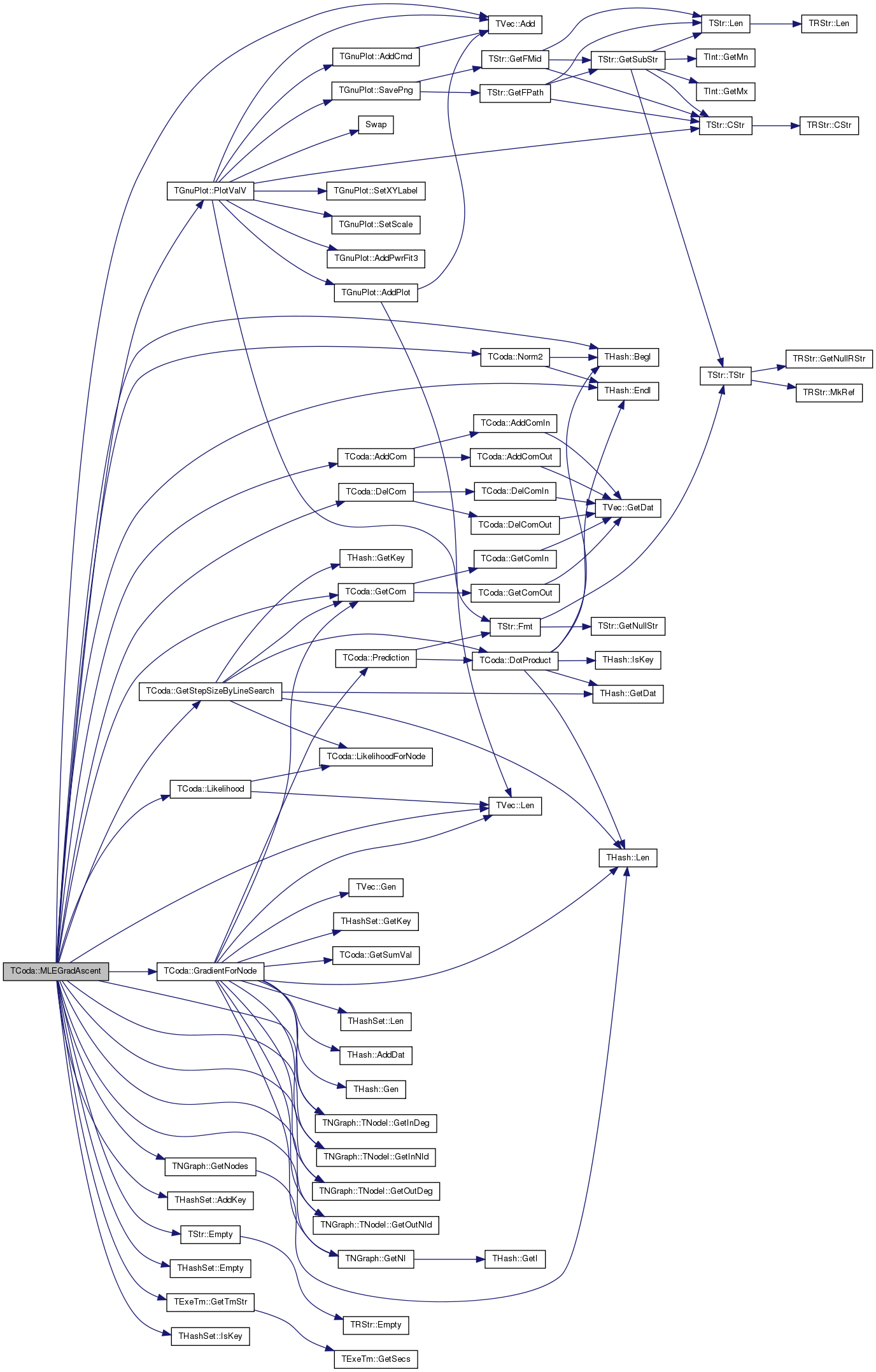

| int TCoda::MLEGradAscentParallel | ( | const double & | Thres, |
| const int & | MaxIter, | ||
| const int | ChunkNum, | ||
| const int | ChunkSize, | ||
| const TStr | PlotNm, | ||
| const double | StepAlpha = 0.3, |
||
| const double | StepBeta = 0.1 |
||
| ) |
Definition at line 962 of file agmdirected.cpp.
References TVec< TVal, TSizeTy >::Add(), THash< TKey, TDat, THashFunc >::AddDat(), THashSet< TKey, THashFunc >::AddKey(), THash< TKey, TDat, THashFunc >::BegI(), THash< TKey, TDat, THashFunc >::Clr(), THash< TKey, TDat, THashFunc >::Defrag(), THash< TKey, TDat, THashFunc >::DelIfKey(), TStr::Empty(), THashSet< TKey, THashFunc >::Empty(), THash< TKey, TDat, THashFunc >::EndI(), TVec< TVal, TSizeTy >::EndI(), F, G, THash< TKey, TDat, THashFunc >::GetDat(), TVec< TVal, TSizeTy >::GetDat(), TNGraph::TNodeI::GetDeg(), TNGraph::TNodeI::GetInDeg(), TNGraph::TNodeI::GetInNId(), THash< TKey, TDat, THashFunc >::GetKey(), TNGraph::TNodeI::GetNbrNId(), TNGraph::GetNI(), TNGraph::GetNodes(), TNGraph::TNodeI::GetOutDeg(), TNGraph::TNodeI::GetOutNId(), GetStepSizeByLineSearch(), GradientForNode(), H, HOVIDSV, IAssert, THash< TKey, TDat, THashFunc >::IsKey(), THashSet< TKey, THashFunc >::IsKey(), THash< TKey, TDat, THashFunc >::Len(), TVec< TVal, TSizeTy >::Len(), Likelihood(), Norm2(), TGnuPlot::PlotValV(), TVec< TVal, TSizeTy >::PutAll(), Rnd, SumFV, and SumHV.
Referenced by FindComsByCV(), and MLEGradAscentParallel().
{
//parallel
time_t InitTime = time(NULL);
//uint64 StartTm = TSecTm::GetCurTm().GetAbsSecs();
TExeTm ExeTm, CheckTm;
double PrevL = Likelihood(true);
TIntFltPrV IterLV;
int PrevIter = 0;
int iter = 0;
TIntV NIdxV(F.Len(), 0);
for (int i = 0; i < F.Len(); i++) { NIdxV.Add(i); }
TIntV NIDOPTV(F.Len()); //check if a node needs optimization or not 1: does not require optimization
NIDOPTV.PutAll(0);
TVec<TIntFltH> NewF(ChunkNum * ChunkSize);
TIntV NewNIDV(ChunkNum * ChunkSize);
TBoolV IsRowV(ChunkNum * ChunkSize);
for (iter = 0; iter < MaxIter; iter++) {
NIdxV.Clr(false);
for (int i = 0; i < F.Len(); i++) {
//if (NIDOPTV[i] == 0) { NIdxV.Add(i); }
NIdxV.Add(i);
}
IAssert (NIdxV.Len() <= F.Len());
NIdxV.Shuffle(Rnd);
// compute gradient for chunk of nodes
#pragma omp parallel for schedule(static, 1)
for (int TIdx = 0; TIdx < ChunkNum; TIdx++) {
TIntFltH GradV;
for (int ui = TIdx * ChunkSize; ui < (TIdx + 1) * ChunkSize; ui++) {
const bool IsRow = (ui % 2 == 0);
NewNIDV[ui] = -1;
if (ui > NIdxV.Len()) { continue; }
const int u = NIdxV[ui]; //
//find set of candidate c (we only need to consider c to which a neighbor of u belongs to)
TNGraph::TNodeI UI = G->GetNI(u);
const int Deg = IsRow? UI.GetOutDeg(): UI.GetInDeg();
TIntSet CIDSet(5 * Deg);
TIntFltH CurFU = IsRow? F[u]: H[u];
for (int e = 0; e < Deg; e++) {
int VID = IsRow? UI.GetOutNId(e): UI.GetInNId(e);
if (HOVIDSV[u].IsKey(VID)) { continue; }
TIntFltH& NbhCIDH = IsRow? H[VID]: F[VID];
for (TIntFltH::TIter CI = NbhCIDH.BegI(); CI < NbhCIDH.EndI(); CI++) {
CIDSet.AddKey(CI.GetKey());
}
}
if (CIDSet.Empty()) {
CurFU.Clr();
}
else {
for (TIntFltH::TIter CI = CurFU.BegI(); CI < CurFU.EndI(); CI++) { //remove the community membership which U does not share with its neighbors
if (! CIDSet.IsKey(CI.GetKey())) {
CurFU.DelIfKey(CI.GetKey());
}
}
GradientForNode(IsRow, u, GradV, CIDSet);
if (Norm2(GradV) < 1e-4) { NIDOPTV[u] = 1; continue; }
double LearnRate = GetStepSizeByLineSearch(IsRow, u, GradV, GradV, StepAlpha, StepBeta);
if (LearnRate == 0.0) { NewNIDV[ui] = -2; continue; }
for (int ci = 0; ci < GradV.Len(); ci++) {
int CID = GradV.GetKey(ci);
double Change = LearnRate * GradV.GetDat(CID);
double NewFuc = CurFU.IsKey(CID)? CurFU.GetDat(CID) + Change : Change;
if (NewFuc <= 0.0) {
CurFU.DelIfKey(CID);
} else {
CurFU.AddDat(CID) = NewFuc;
}
}
CurFU.Defrag();
}
//store changes
NewF[ui] = CurFU;
NewNIDV[ui] = u;
IsRowV[ui] = IsRow;
}
}
int NumNoChangeGrad = 0;
int NumNoChangeStepSize = 0;
for (int ui = 0; ui < NewNIDV.Len(); ui++) {
int NewNID = NewNIDV[ui];
if (NewNID == -1) { NumNoChangeGrad++; continue; }
if (NewNID == -2) { NumNoChangeStepSize++; continue; }
if (IsRowV[ui]) {
for (TIntFltH::TIter CI = F[NewNID].BegI(); CI < F[NewNID].EndI(); CI++) {
SumFV[CI.GetKey()] -= CI.GetDat();
}
} else {
for (TIntFltH::TIter CI = H[NewNID].BegI(); CI < H[NewNID].EndI(); CI++) {
SumHV[CI.GetKey()] -= CI.GetDat();
}
}
}
#pragma omp parallel for
for (int ui = 0; ui < NewNIDV.Len(); ui++) {
int NewNID = NewNIDV[ui];
if (NewNID < 0) { continue; }
if (IsRowV[ui]) {
F[NewNID] = NewF[ui];
} else {
H[NewNID] = NewF[ui];
}
}
for (int ui = 0; ui < NewNIDV.Len(); ui++) {
int NewNID = NewNIDV[ui];
if (NewNID < 0) { continue; }
if (IsRowV[ui]) {
for (TIntFltH::TIter CI = F[NewNID].BegI(); CI < F[NewNID].EndI(); CI++) {
SumFV[CI.GetKey()] += CI.GetDat();
}
} else {
for (TIntFltH::TIter CI = H[NewNID].BegI(); CI < H[NewNID].EndI(); CI++) {
SumHV[CI.GetKey()] += CI.GetDat();
}
}
}
// update the nodes who are optimal
for (int ui = 0; ui < NewNIDV.Len(); ui++) {
int NewNID = NewNIDV[ui];
if (NewNID < 0) { continue; }
TNGraph::TNodeI UI = G->GetNI(NewNID);
NIDOPTV[NewNID] = 0;
for (int e = 0; e < UI.GetDeg(); e++) {
NIDOPTV[UI.GetNbrNId(e)] = 0;
}
}
int OPTCnt = 0;
for (int i = 0; i < NIDOPTV.Len(); i++) { if (NIDOPTV[i] == 1) { OPTCnt++; } }
/*
if (! PlotNm.Empty()) {
printf("\r%d iterations [%s] %lu secs", iter * ChunkSize * ChunkNum, ExeTm.GetTmStr(), TSecTm::GetCurTm().GetAbsSecs() - StartTm);
if (PrevL > TFlt::Mn) { printf(" (%f) %d g %d s %d OPT", PrevL, NumNoChangeGrad, NumNoChangeStepSize, OPTCnt); }
fflush(stdout);
}
*/
if ((iter - PrevIter) * ChunkSize * ChunkNum >= G->GetNodes()) {
PrevIter = iter;
double CurL = Likelihood(true);
IterLV.Add(TIntFltPr(iter * ChunkSize * ChunkNum, CurL));
printf("\r%d iterations, Likelihood: %f, Diff: %f [%lu secs]", iter, CurL, CurL - PrevL, time(NULL) - InitTime);
fflush(stdout);
if (CurL - PrevL <= Thres * fabs(PrevL)) {
break;
}
else {
PrevL = CurL;
}
}
}
if (! PlotNm.Empty()) {
printf("\nMLE completed with %d iterations(%lu secs)\n", iter, time(NULL) - InitTime);
TGnuPlot::PlotValV(IterLV, PlotNm + ".likelihood_Q");
} else {
printf("\rMLE completed with %d iterations(%lu secs)\n", iter, time(NULL) - InitTime);
fflush(stdout);
}
return iter;
}
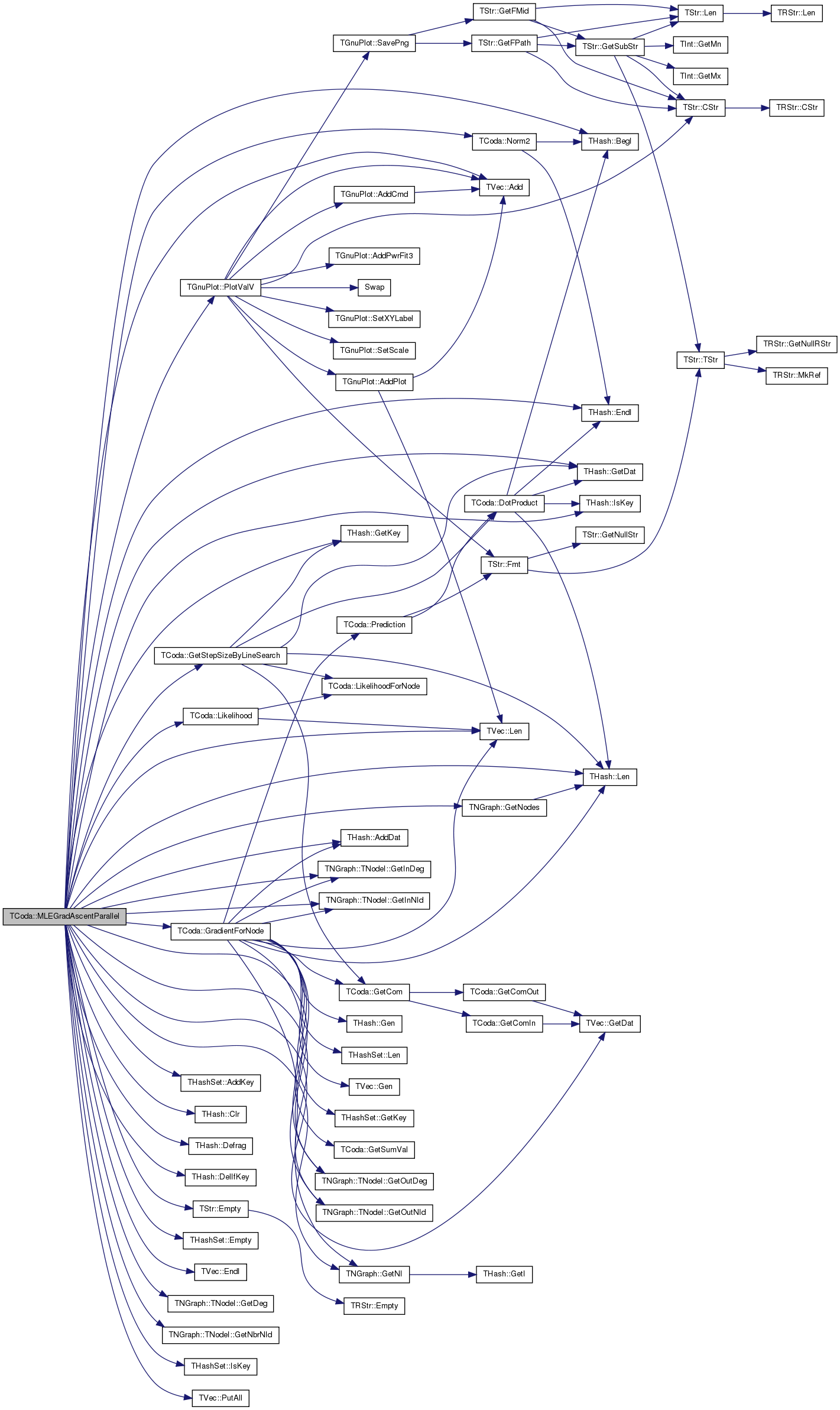

| int TCoda::MLEGradAscentParallel | ( | const double & | Thres, |
| const int & | MaxIter, | ||
| const int | ChunkNum, | ||
| const TStr | PlotNm = TStr(), |
||
| const double | StepAlpha = 0.3, |
||
| const double | StepBeta = 0.1 |
||
| ) | [inline] |
Definition at line 74 of file agmdirected.h.
References G, TNGraph::GetNodes(), and MLEGradAscentParallel().
{
int ChunkSize = G->GetNodes() / 10 / ChunkNum;
if (ChunkSize == 0) { ChunkSize = 1; }
return MLEGradAscentParallel(Thres, MaxIter, ChunkNum, ChunkSize, PlotNm, StepAlpha, StepBeta);
}
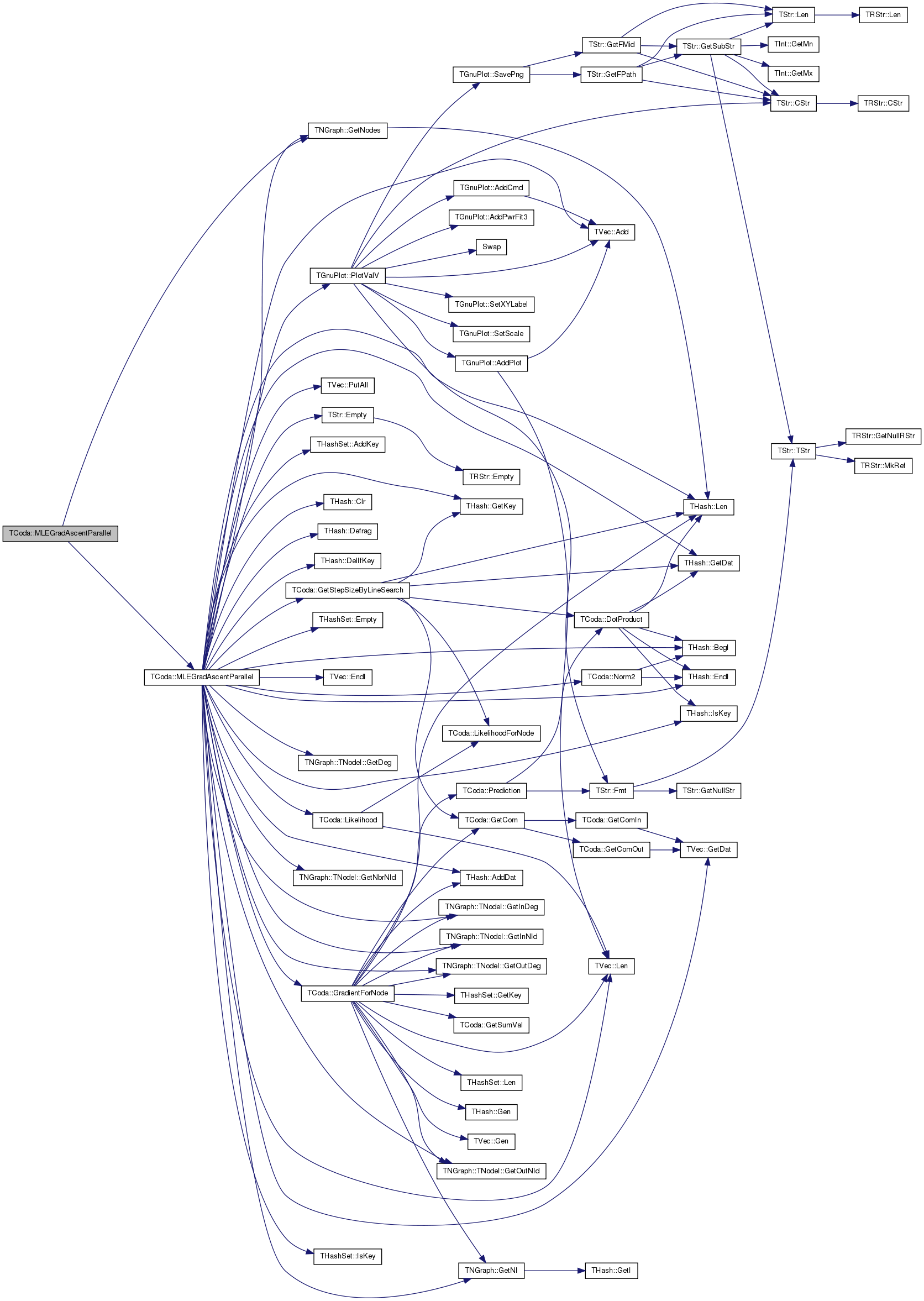
| void TCoda::NeighborComInit | ( | const int | InitComs | ) |
Definition at line 83 of file agmdirected.cpp.
References F, G, and TVec< TVal, TSizeTy >::Len().
Referenced by FindComsByCV().
{
//initialize with best neighborhood communities (Gleich et.al. KDD'12)
TExeTm RunTm;
TFltIntPrV NIdPhiV(F.Len(), 0);
TAGMFastUtil::GetNIdPhiV<PNGraph>(G, NIdPhiV);
NeighborComInit(NIdPhiV, InitComs);
}


| void TCoda::NeighborComInit | ( | TFltIntPrV & | NIdPhiV, |
| const int | InitComs | ||
| ) |
Definition at line 91 of file agmdirected.cpp.
References AddComIn(), AddComOut(), F, G, TVec< TVal, TSizeTy >::Gen(), TNGraph::TNodeI::GetDeg(), TNGraph::TNodeI::GetInDeg(), TNGraph::TNodeI::GetNbrNId(), TNGraph::GetNI(), TNGraph::GetNodes(), TNGraph::TNodeI::GetOutDeg(), TRnd::GetUniDev(), TRnd::GetUniDevInt(), H, TVec< TVal, TSizeTy >::Len(), NumComs, Rnd, TVec< TVal, TSizeTy >::Sort(), SumFV, and SumHV.
{
NIdPhiV.Sort(true);
F.Gen(G->GetNodes());
H.Gen(G->GetNodes());
SumFV.Gen(InitComs);
SumHV.Gen(InitComs);
NumComs = InitComs;
//TIntFltH NCPhiH(F.Len());
TIntSet InvalidNIDS(F.Len());
TIntV ChosenNIDV(InitComs, 0); //FOR DEBUG
//choose nodes with local minimum in conductance
int CurCID = 0;
for (int ui = 0; ui < NIdPhiV.Len(); ui++) {
int UID = NIdPhiV[ui].Val2;
fflush(stdout);
if (InvalidNIDS.IsKey(UID)) { continue; }
ChosenNIDV.Add(UID); //FOR DEBUG
//add the node and its neighbors to the current community
TNGraph::TNodeI NI = G->GetNI(UID);
if (NI.GetOutDeg() > 0) { AddComOut(UID, CurCID, 1.0); }
if (NI.GetInDeg() > 0) { AddComIn(UID, CurCID, 1.0); }
fflush(stdout);
//add neighbors depending on whether they have incoming / outgoing edges from the center node (NI)
for (int e = 0; e < NI.GetDeg(); e++) {
int VID = NI.GetNbrNId(e);
TNGraph::TNodeI VI = G->GetNI(VID);
if (VI.GetOutDeg() > 0) { AddComOut(VID, CurCID, 1.0); }
if (VI.GetInDeg() > 0) { AddComIn(VID, CurCID, 1.0); }
}
//exclude its neighbors from the next considerations
for (int e = 0; e < NI.GetDeg(); e++) {
InvalidNIDS.AddKey(NI.GetNbrNId(e));
}
CurCID++;
fflush(stdout);
if (CurCID >= NumComs) { break; }
}
if (NumComs > CurCID) {
printf("%d communities needed to fill randomly\n", NumComs - CurCID);
}
//assign a member to zero-member community (if any)
for (int c = 0; c < SumFV.Len(); c++) {
if (SumFV[c] == 0.0) {
int ComSz = 10;
for (int u = 0; u < ComSz; u++) {
int UID = Rnd.GetUniDevInt(G->GetNodes());
AddComOut(UID, c, Rnd.GetUniDev());
}
}
}
//assign a member to zero-member community (if any)
for (int c = 0; c < SumHV.Len(); c++) {
if (SumHV[c] == 0.0) {
int ComSz = 10;
for (int u = 0; u < ComSz; u++) {
int UID = Rnd.GetUniDevInt(G->GetNodes());
AddComIn(UID, c, Rnd.GetUniDev());
}
}
}
}
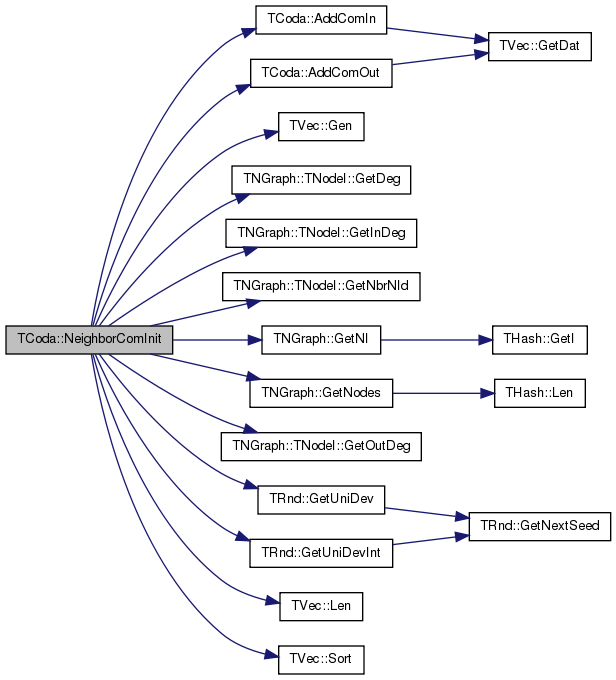
| double TCoda::Norm2 | ( | const TIntFltH & | UV | ) | [inline] |
Definition at line 189 of file agmdirected.h.
References THash< TKey, TDat, THashFunc >::BegI(), and THash< TKey, TDat, THashFunc >::EndI().
Referenced by LikelihoodForNode(), MLEGradAscent(), and MLEGradAscentParallel().
{
double N = 0.0;
for (TIntFltH::TIter HI = UV.BegI(); HI < UV.EndI(); HI++) {
N += HI.GetDat() * HI.GetDat();
}
return N;
}


| double TCoda::Prediction | ( | const TIntFltH & | FU, |
| const TIntFltH & | HV | ||
| ) | [inline] |
Definition at line 174 of file agmdirected.h.
References DotProduct(), TStr::Fmt(), IAssertR, and PNoCom.
Referenced by GetNonEdgePairScores(), GradientForNode(), LikelihoodForNode(), LikelihoodHoldOut(), and Prediction().
{
double DP = log (1.0 / (1.0 - PNoCom)) + DotProduct(FU, HV);
IAssertR(DP > 0.0, TStr::Fmt("DP: %f", DP));
return exp(- DP);
}
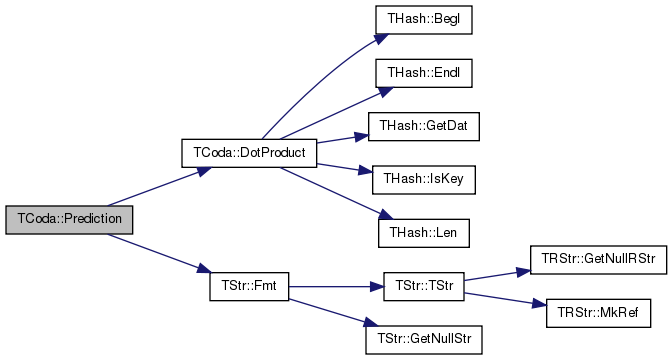

| double TCoda::Prediction | ( | const int & | UID, |
| const int & | VID | ||
| ) | [inline] |
Definition at line 179 of file agmdirected.h.
References F, H, and Prediction().
{
return Prediction(F[UID], H[VID]);
}
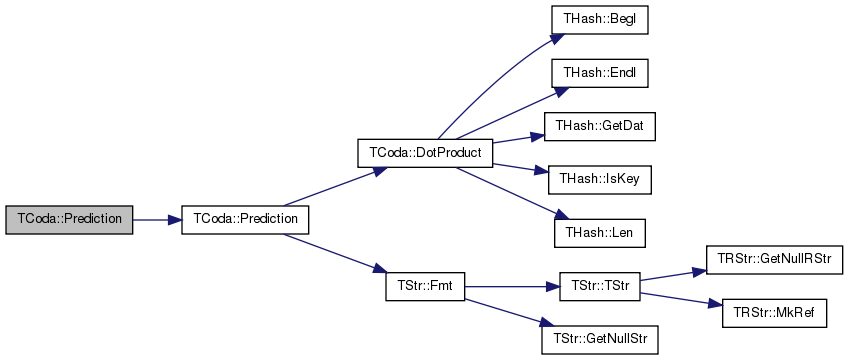
| void TCoda::RandomInit | ( | const int | InitComs | ) |
Definition at line 43 of file agmdirected.cpp.
References AddComIn(), AddComOut(), F, G, TVec< TVal, TSizeTy >::Gen(), TNGraph::TNodeI::GetInDeg(), TNGraph::GetNI(), TNGraph::GetNodes(), TNGraph::TNodeI::GetOutDeg(), TRnd::GetUniDev(), TRnd::GetUniDevInt(), H, TVec< TVal, TSizeTy >::Len(), NumComs, Rnd, SumFV, and SumHV.
Referenced by FindComsByCV(), and TCoda().
{
F.Gen(G->GetNodes());
H.Gen(G->GetNodes());
SumFV.Gen(InitComs);
SumHV.Gen(InitComs);
NumComs = InitComs;
for (int u = 0; u < F.Len(); u++) {
//assign to just one community
int Mem = G->GetNI(u).GetOutDeg();
if (Mem > 10) { Mem = 10; }
for (int c = 0; c < Mem; c++) {
int CID = Rnd.GetUniDevInt(InitComs);
AddComOut(u, CID, Rnd.GetUniDev());
}
}
for (int u = 0; u < H.Len(); u++) {
//assign to just one community
int Mem = G->GetNI(u).GetInDeg();
if (Mem > 10) { Mem = 10; }
for (int c = 0; c < Mem; c++) {
int CID = Rnd.GetUniDevInt(InitComs);
AddComIn(u, CID, Rnd.GetUniDev());
}
}
//assign a member to zero-member community (if any)
for (int c = 0; c < SumFV.Len(); c++) {
if (SumFV[c] == 0.0) {
int UID = Rnd.GetUniDevInt(G->GetNodes());
AddComOut(UID, c, Rnd.GetUniDev());
}
}
//assign a member to zero-member community (if any)
for (int c = 0; c < SumHV.Len(); c++) {
if (SumHV[c] == 0.0) {
int UID = Rnd.GetUniDevInt(G->GetNodes());
AddComIn(UID, c, Rnd.GetUniDev());
}
}
}
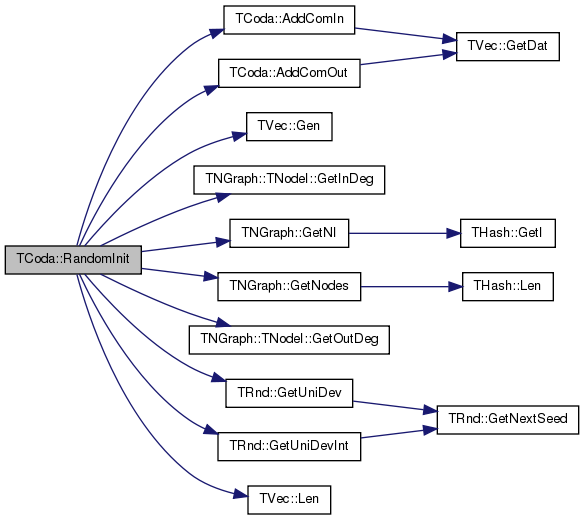

| void TCoda::Save | ( | TSOut & | SOut | ) |
Definition at line 8 of file agmdirected.cpp.
References F, G, H, HOVIDSV, MaxVal, MinVal, NegWgt, NIDV, NodesOk, NumComs, PNoCom, RegCoef, TNGraph::Save(), TVec< TVal, TSizeTy >::Save(), TBool::Save(), TInt::Save(), TFlt::Save(), SumFV, and SumHV.
{
G->Save(SOut);
F.Save(SOut);
H.Save(SOut);
NIDV.Save(SOut);
RegCoef.Save(SOut);
SumFV.Save(SOut);
SumHV.Save(SOut);
NodesOk.Save(SOut);
MinVal.Save(SOut);
MaxVal.Save(SOut);
NegWgt.Save(SOut);
NumComs.Save(SOut);
HOVIDSV.Save(SOut);
PNoCom.Save(SOut);
}
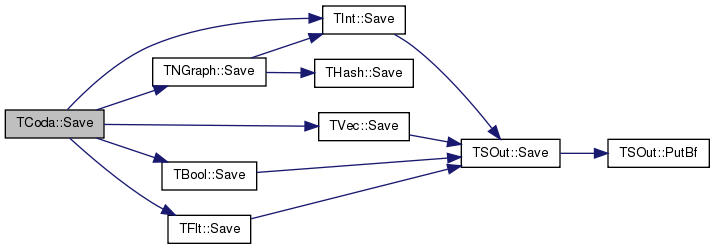
| void TCoda::SetCmtyVV | ( | const TVec< TIntV > & | CmtyVVOut, |
| const TVec< TIntV > & | CmtyVVIn | ||
| ) |
Definition at line 171 of file agmdirected.cpp.
References AddComIn(), AddComOut(), THash< TKey, TDat, THashFunc >::AddDat(), F, G, TVec< TVal, TSizeTy >::Gen(), TVec< TVal, TSizeTy >::GetDat(), TNGraph::GetNodes(), H, IAssert, TNGraph::IsNode(), TVec< TVal, TSizeTy >::Len(), NIDV, NodesOk, NumComs, SumFV, and SumHV.
{
IAssert(CmtyVVOut.Len() == CmtyVVIn.Len());
F.Gen(G->GetNodes());
H.Gen(G->GetNodes());
SumFV.Gen(CmtyVVOut.Len());
SumHV.Gen(CmtyVVIn.Len());
NumComs = CmtyVVOut.Len();
TIntH NIDIdxH(NIDV.Len());
if (! NodesOk) {
for (int u = 0; u < NIDV.Len(); u++) {
NIDIdxH.AddDat(NIDV[u], u);
}
}
for (int c = 0; c < CmtyVVOut.Len(); c++) {
for (int u = 0; u < CmtyVVOut[c].Len(); u++) {
int UID = CmtyVVOut[c][u];
if (! NodesOk) { UID = NIDIdxH.GetDat(UID); }
if (G->IsNode(UID)) {
AddComOut(UID, c, 1.0);
}
}
}
for (int c = 0; c < CmtyVVIn.Len(); c++) {
for (int u = 0; u < CmtyVVIn[c].Len(); u++) {
int UID = CmtyVVIn[c][u];
if (! NodesOk) { UID = NIDIdxH.GetDat(UID); }
if (G->IsNode(UID)) {
AddComIn(UID, c, 1.0);
}
}
}
}
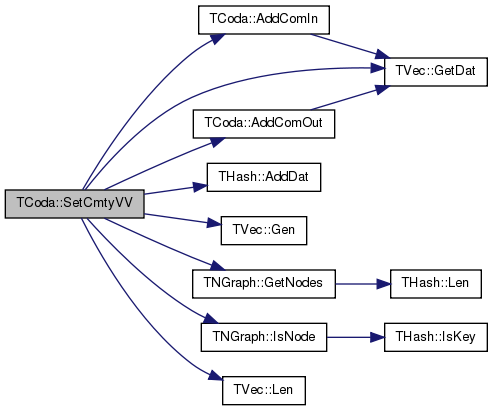
| void TCoda::SetGraph | ( | const PNGraph & | GraphPt | ) |
Definition at line 204 of file agmdirected.cpp.
References TSnap::DelSelfEdges(), DoParallel, G, TVec< TVal, TSizeTy >::Gen(), TNGraph::GetNIdV(), TNGraph::GetNodes(), TSnap::GetSubGraph(), HOVIDSV, IAssert, TNGraph::IsNode(), TFlt::Mx, NegWgt, NIDV, NodesOk, and PNoCom.
Referenced by TCoda().
{
G = GraphPt;
HOVIDSV.Gen(G->GetNodes());
NodesOk = true;
GraphPt->GetNIdV(NIDV);
// check that nodes IDs are {0,1,..,Nodes-1}
for (int nid = 0; nid < GraphPt->GetNodes(); nid++) {
if (! GraphPt->IsNode(nid)) {
NodesOk = false;
break;
}
}
if (! NodesOk) {
printf("rearrage nodes\n");
G = TSnap::GetSubGraph(GraphPt, NIDV, true);
for (int nid = 0; nid < G->GetNodes(); nid++) {
IAssert(G->IsNode(nid));
}
}
TSnap::DelSelfEdges(G);
PNoCom = 1.0 / (double) G->GetNodes();
DoParallel = false;
if (1.0 / PNoCom > sqrt(TFlt::Mx)) { PNoCom = 0.99 / sqrt(TFlt::Mx); } // to prevent overflow
NegWgt = 1.0;
}
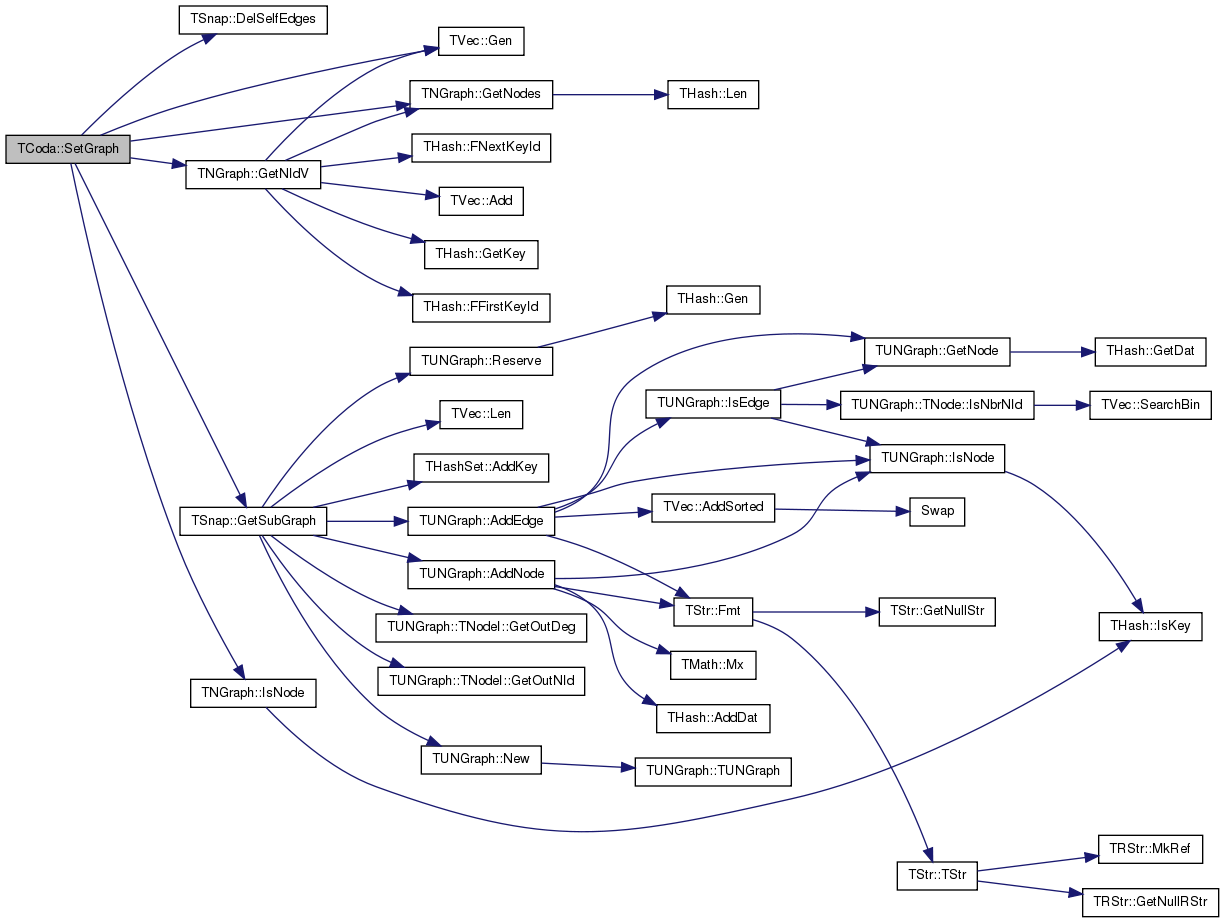

| void TCoda::SetHoldOut | ( | const double | HOFrac | ) | [inline] |
Definition at line 54 of file agmdirected.h.
References G, TAGMFastUtil::GenHoldOutPairs(), HOVIDSV, and Rnd.
{ TVec<TIntSet> HoldOut; TAGMFastUtil::GenHoldOutPairs(G, HoldOut, HOFrac, Rnd); HOVIDSV = HoldOut; }

| void TCoda::SetRegCoef | ( | const double | _RegCoef | ) | [inline] |
| double TCoda::Sum | ( | const TIntFltH & | UV | ) | [inline] |
Definition at line 182 of file agmdirected.h.
References THash< TKey, TDat, THashFunc >::BegI(), and THash< TKey, TDat, THashFunc >::EndI().
Referenced by LikelihoodForNode().
{
double N = 0.0;
for (TIntFltH::TIter HI = UV.BegI(); HI < UV.EndI(); HI++) {
N += HI.GetDat();
}
return N;
}


Definition at line 25 of file agmdirected.h.
Referenced by SetGraph().
Definition at line 10 of file agmdirected.h.
Referenced by AddComOut(), DelComOut(), DotProductUtoV(), GetCommunity(), GetComOut(), Likelihood(), LikelihoodForNode(), Load(), MLEGradAscent(), MLEGradAscentParallel(), NeighborComInit(), Prediction(), RandomInit(), Save(), and SetCmtyVV().
Definition at line 9 of file agmdirected.h.
Referenced by DumpMemberships(), FindComsByCV(), GetCmtyS(), GetCmtyVV(), GetCmtyVVUnSorted(), GetGraph(), GetGraphRawNID(), GetNonEdgePairScores(), GradientForNode(), LikelihoodForNode(), LikelihoodHoldOut(), Load(), MLEGradAscent(), MLEGradAscentParallel(), NeighborComInit(), RandomInit(), Save(), SetCmtyVV(), SetGraph(), SetHoldOut(), and TCoda().
Definition at line 11 of file agmdirected.h.
Referenced by AddComIn(), DelComIn(), DotProductUtoV(), GetComIn(), LikelihoodForNode(), Load(), MLEGradAscent(), MLEGradAscentParallel(), NeighborComInit(), Prediction(), RandomInit(), Save(), and SetCmtyVV().
TVec<TIntSet> TCoda::HOVIDSV [private] |
Definition at line 19 of file agmdirected.h.
Referenced by FindComsByCV(), GradientForNode(), LikelihoodForNode(), LikelihoodHoldOut(), Load(), MLEGradAscent(), MLEGradAscentParallel(), Save(), SetGraph(), and SetHoldOut().
Definition at line 22 of file agmdirected.h.
Referenced by GetStepSizeByLineSearch(), Load(), and Save().
Definition at line 21 of file agmdirected.h.
Referenced by GetStepSizeByLineSearch(), Load(), and Save().
Definition at line 23 of file agmdirected.h.
Referenced by GradientForNode(), LikelihoodForNode(), LikelihoodHoldOut(), Load(), Save(), and SetGraph().
TIntV TCoda::NIDV [private] |
Definition at line 13 of file agmdirected.h.
Referenced by DumpMemberships(), GetCmtyS(), GetCmtyVVUnSorted(), GetCommunity(), GetGraphRawNID(), GetNIDValH(), GetNonEdgePairScores(), Load(), Save(), SetCmtyVV(), and SetGraph().
TBool TCoda::NodesOk [private] |
Definition at line 17 of file agmdirected.h.
Referenced by GetCommunity(), Load(), Save(), SetCmtyVV(), and SetGraph().
TInt TCoda::NumComs [private] |
Definition at line 18 of file agmdirected.h.
Referenced by DumpMemberships(), GetCmtyVV(), GetCmtyVVUnSorted(), GetNumComs(), GradientForNode(), LikelihoodForNode(), Load(), MLEGradAscent(), NeighborComInit(), RandomInit(), Save(), and SetCmtyVV().
Definition at line 24 of file agmdirected.h.
Referenced by DumpMemberships(), GetCommunity(), Load(), Prediction(), Save(), SetGraph(), and TCodaAnalyzer::TCodaAnalyzer().
TFlt TCoda::RegCoef [private] |
Definition at line 14 of file agmdirected.h.
Referenced by GetRegCoef(), GradientForNode(), LikelihoodForNode(), Load(), Save(), and SetRegCoef().
TRnd TCoda::Rnd [private] |
Definition at line 12 of file agmdirected.h.
Referenced by FindComsByCV(), Load(), MLEGradAscent(), MLEGradAscentParallel(), NeighborComInit(), RandomInit(), and SetHoldOut().
TFltV TCoda::SumFV [private] |
Definition at line 15 of file agmdirected.h.
Referenced by AddComOut(), DelComOut(), GetSumVal(), Load(), MLEGradAscentParallel(), NeighborComInit(), RandomInit(), Save(), and SetCmtyVV().
TFltV TCoda::SumHV [private] |
Definition at line 16 of file agmdirected.h.
Referenced by AddComIn(), DelComIn(), GetSumVal(), GradientForNode(), LikelihoodForNode(), Load(), MLEGradAscentParallel(), NeighborComInit(), RandomInit(), Save(), and SetCmtyVV().